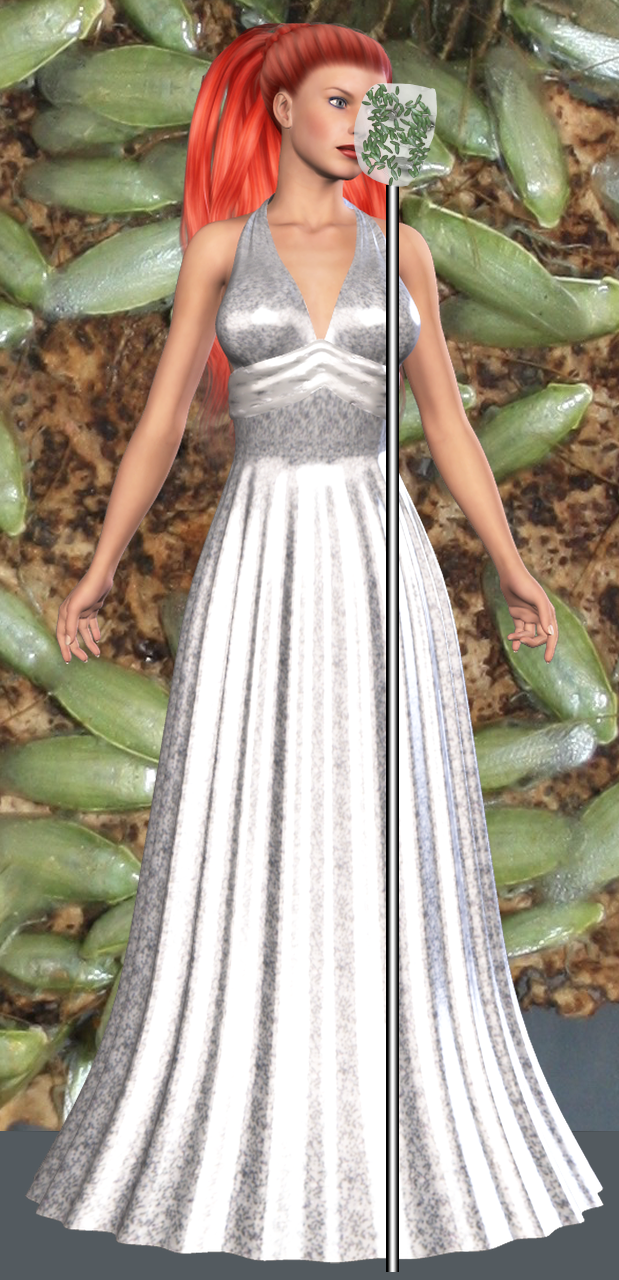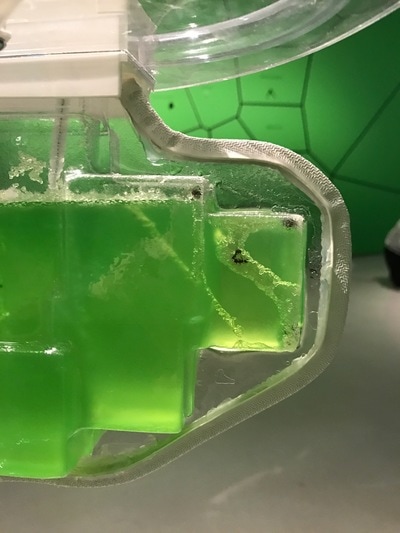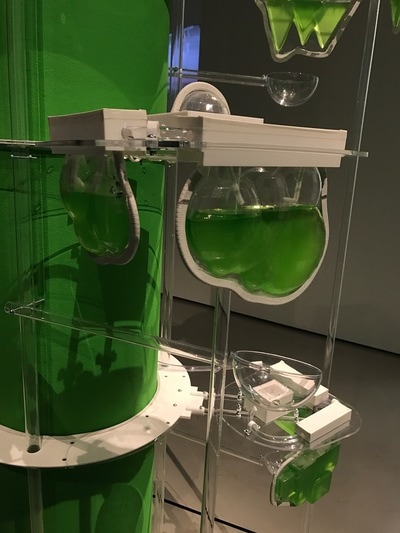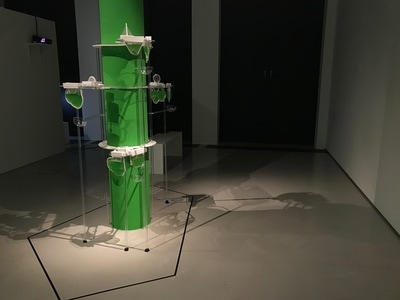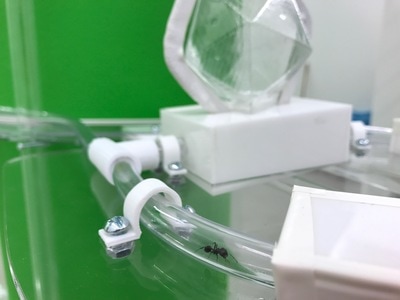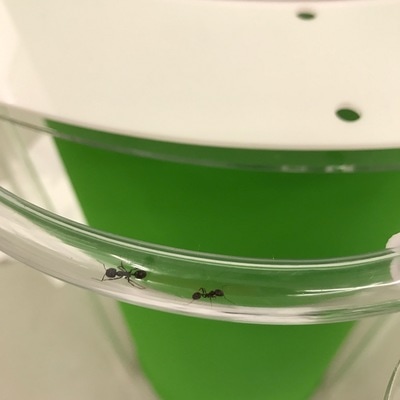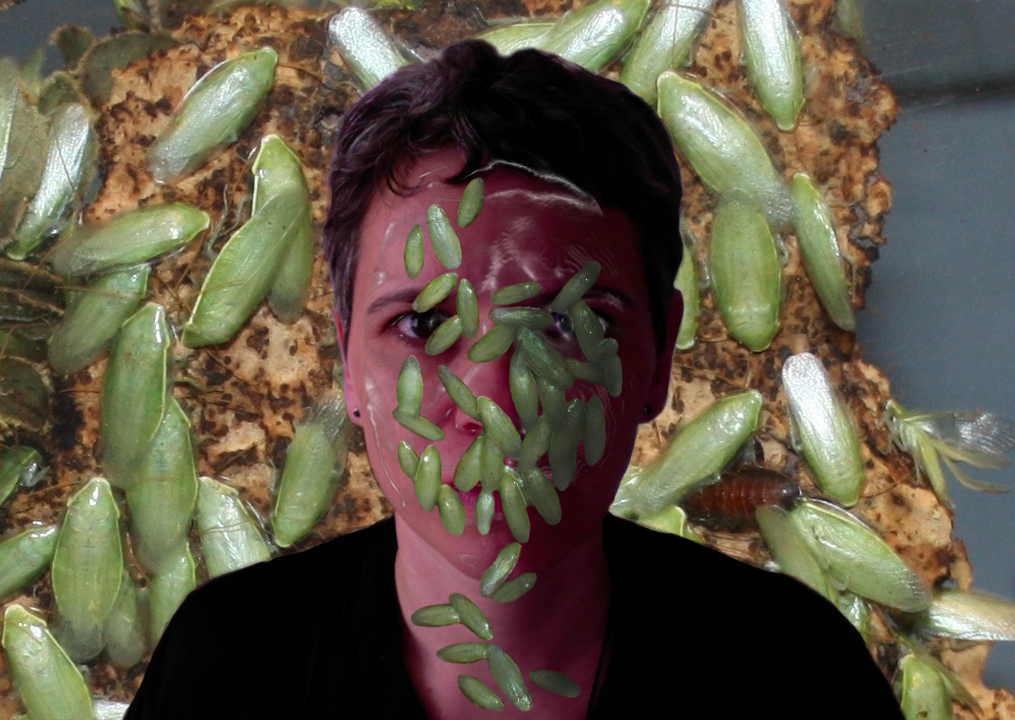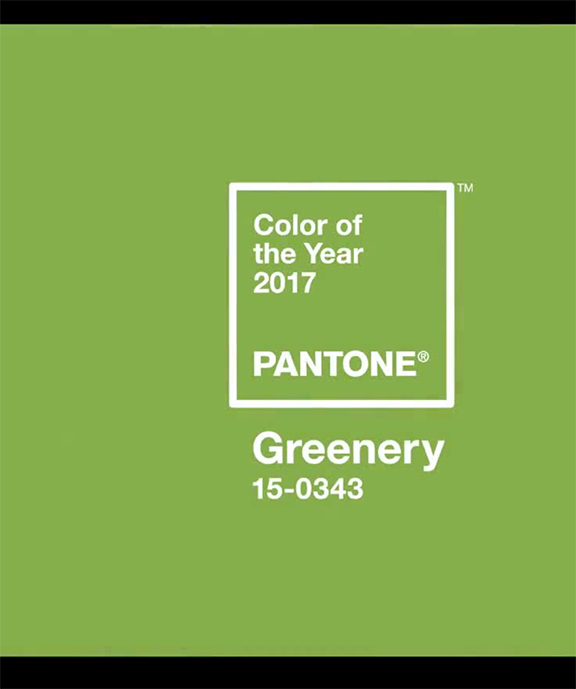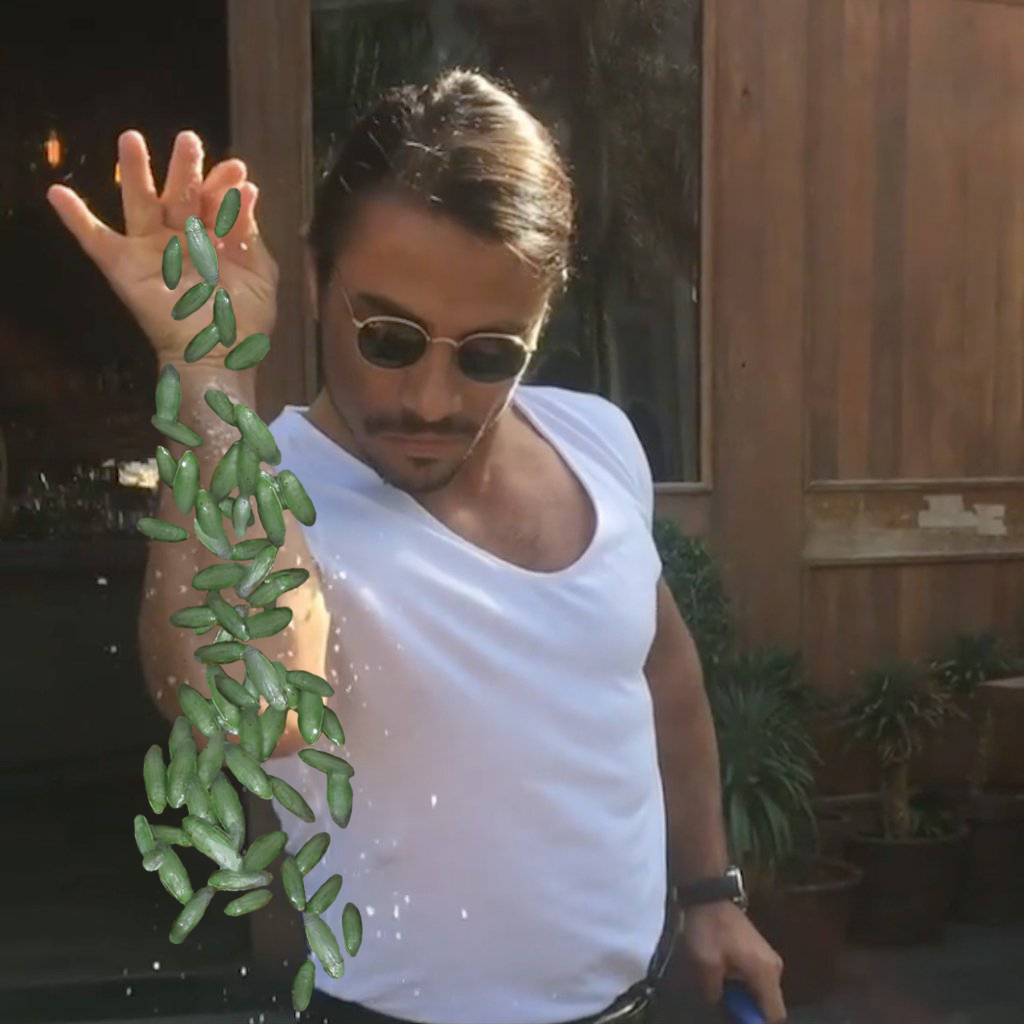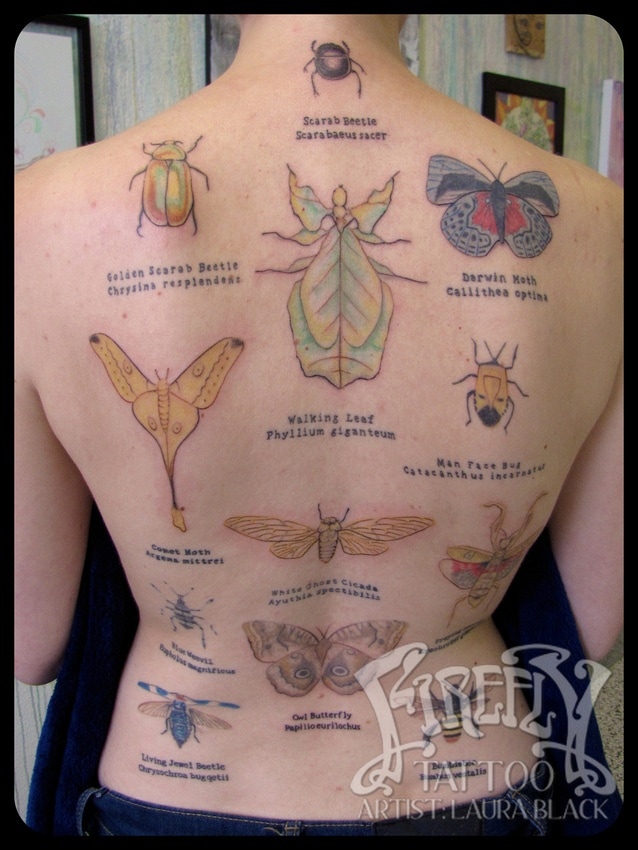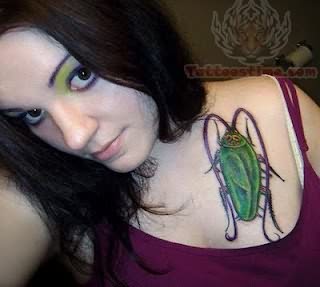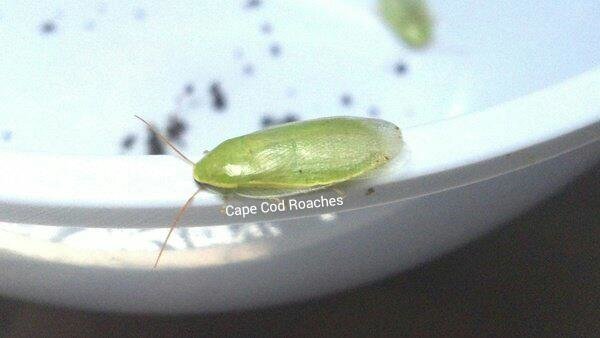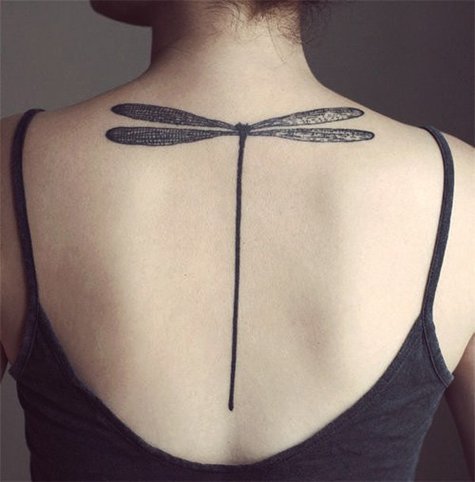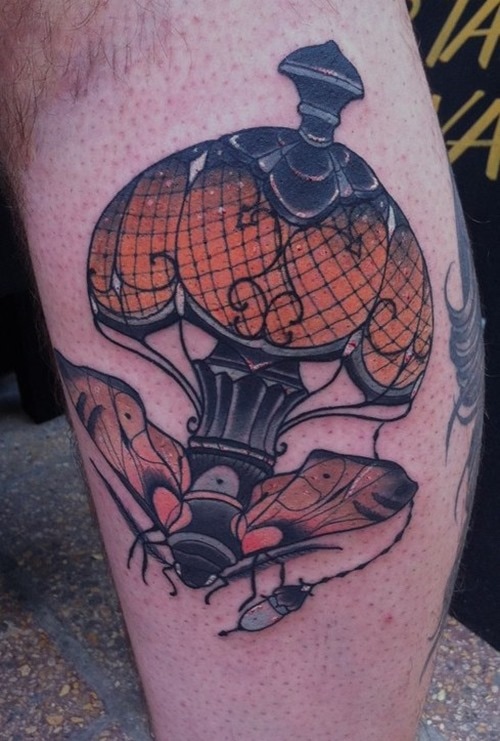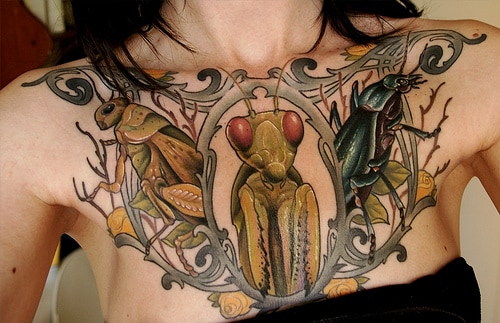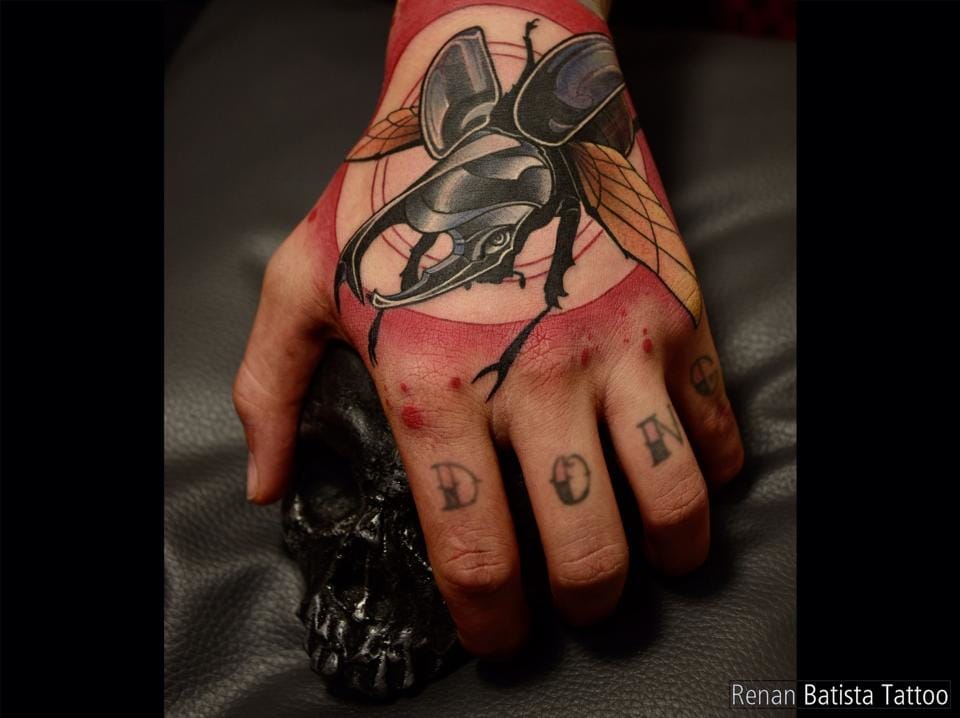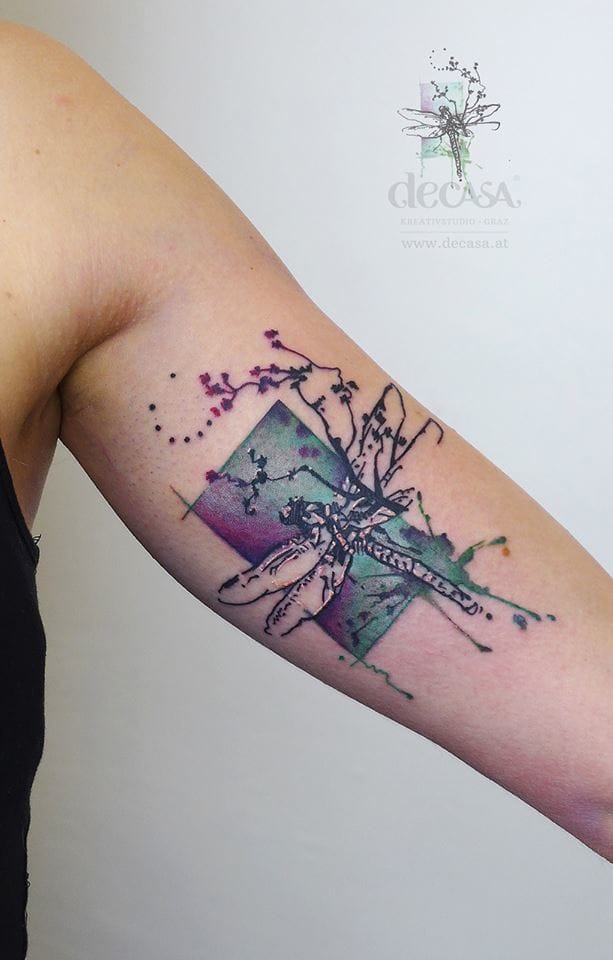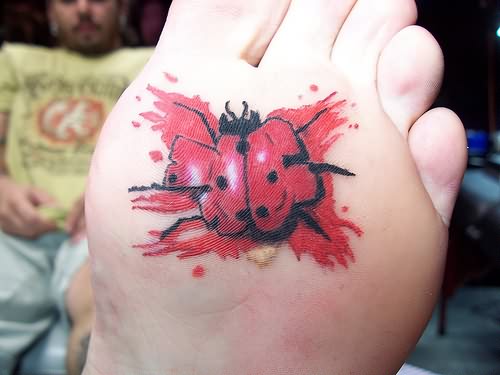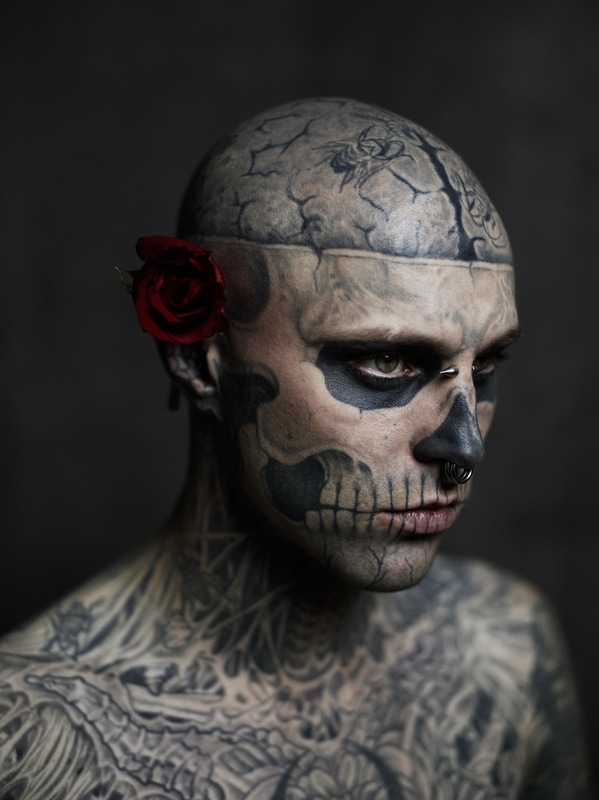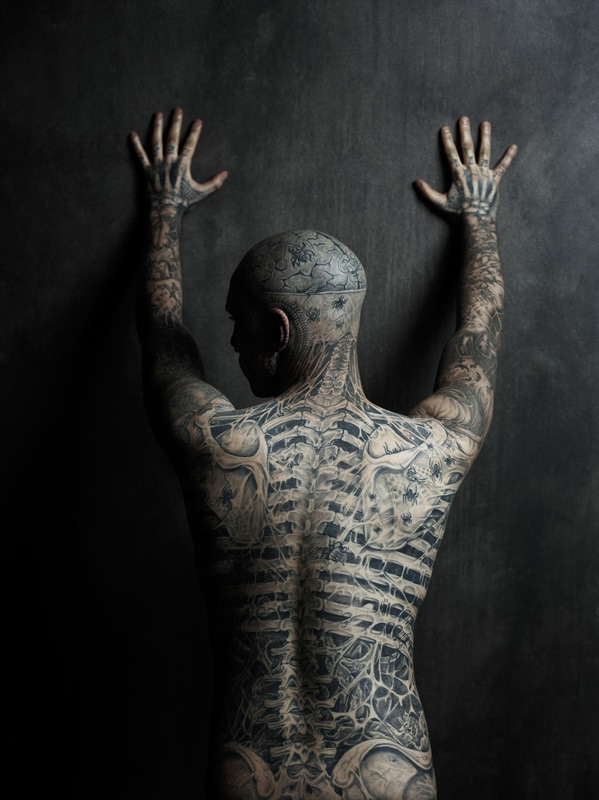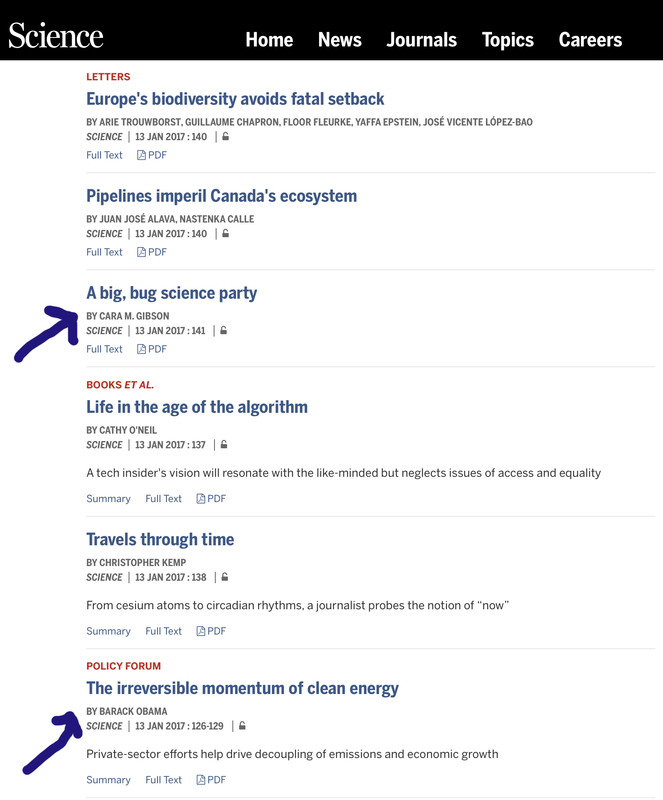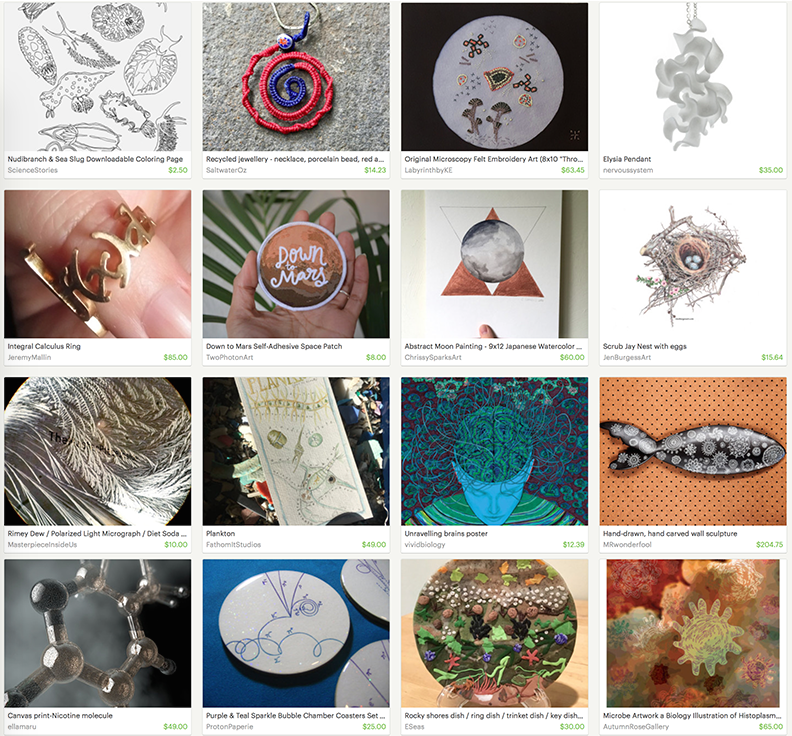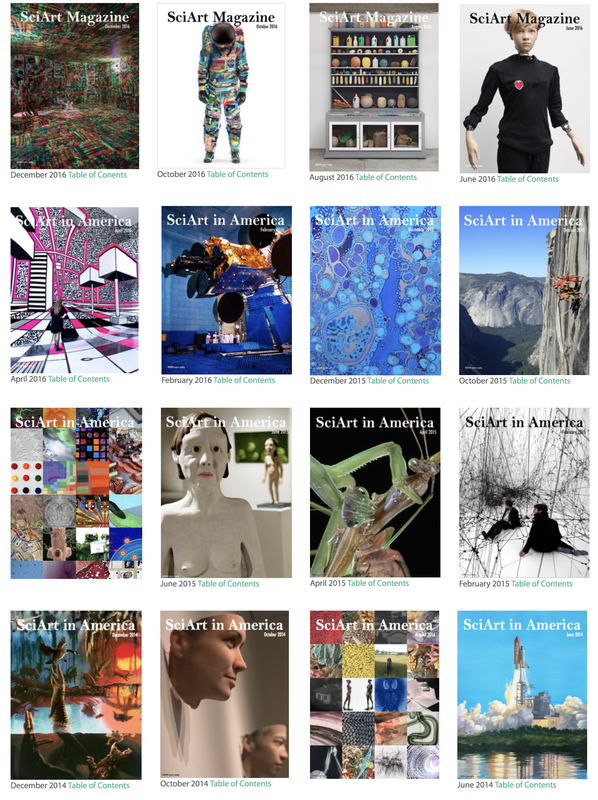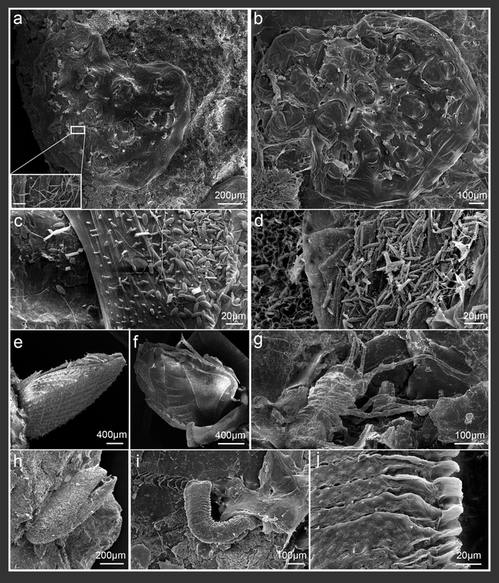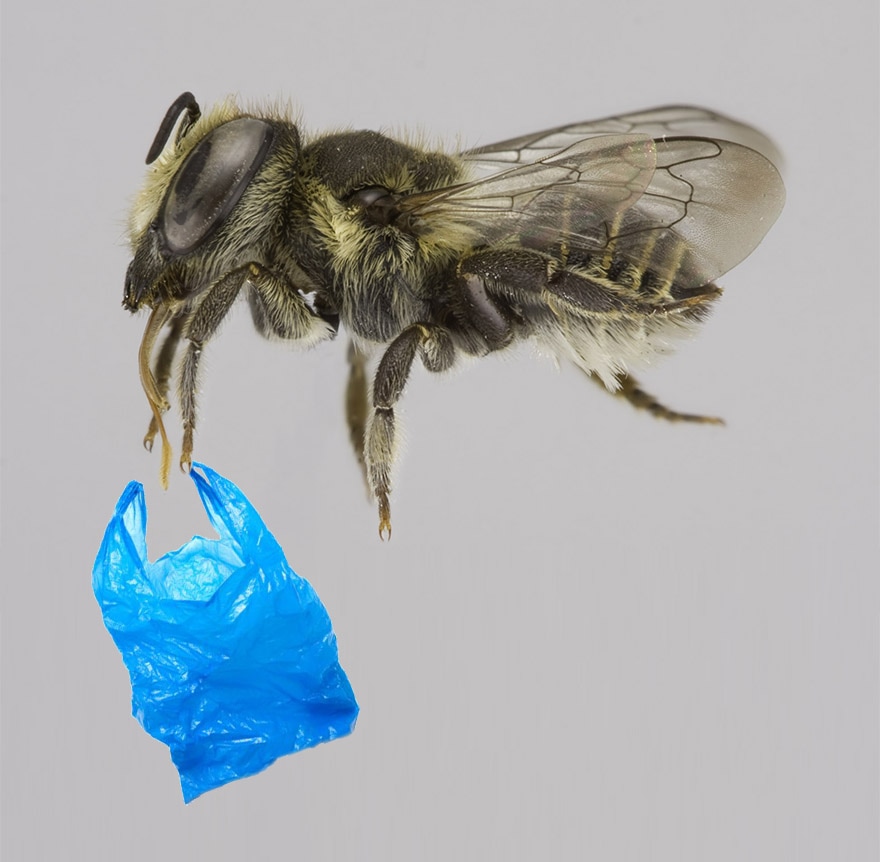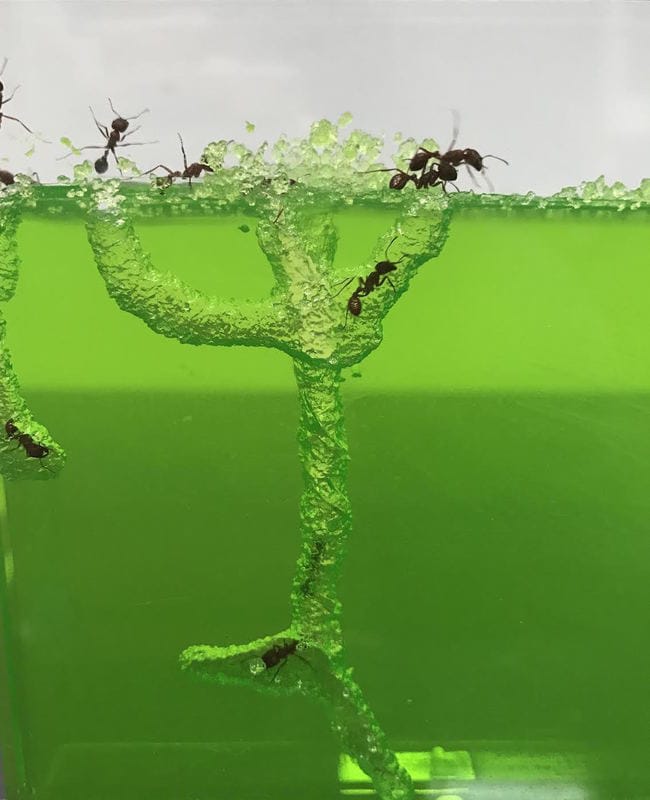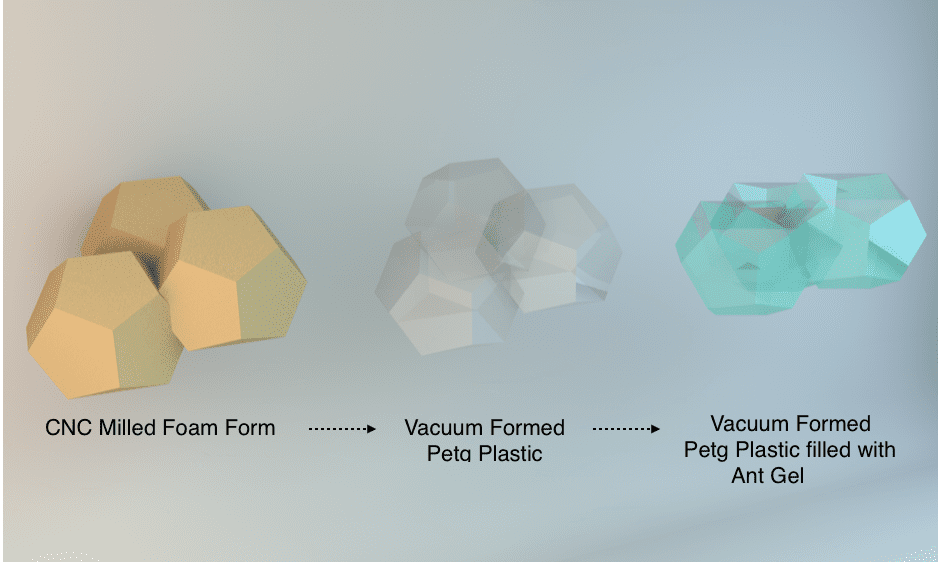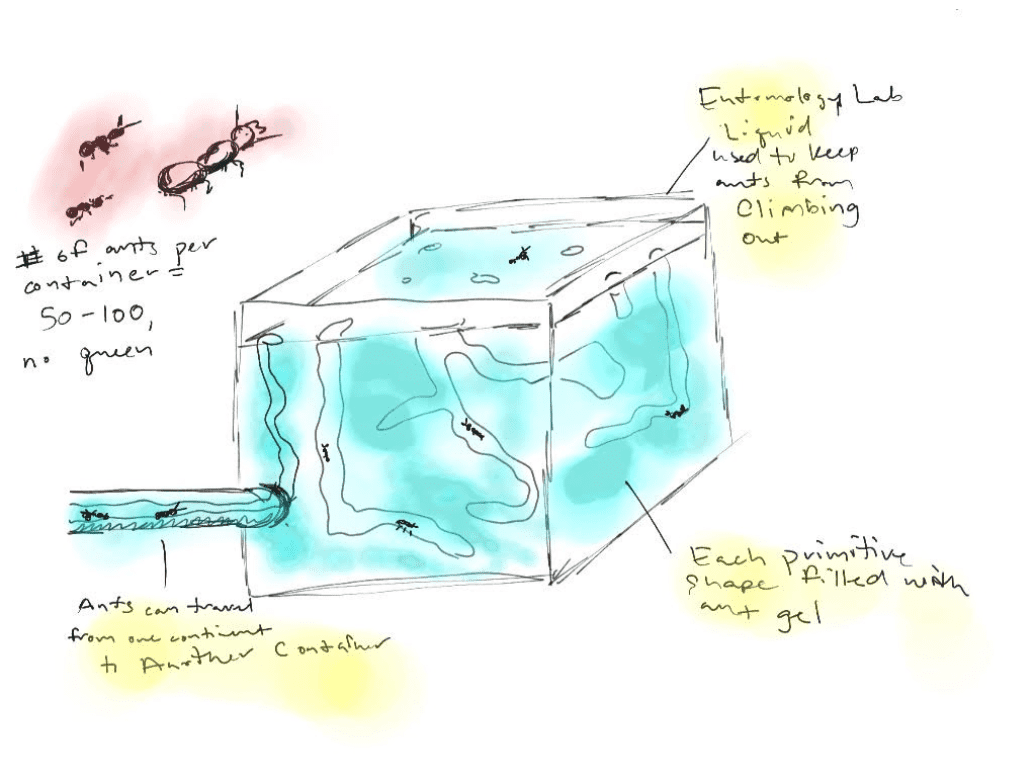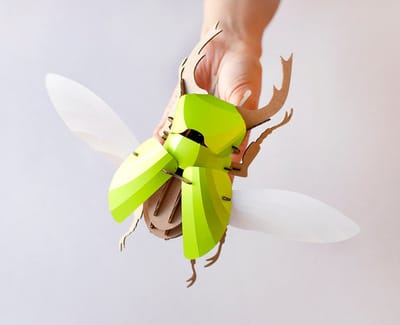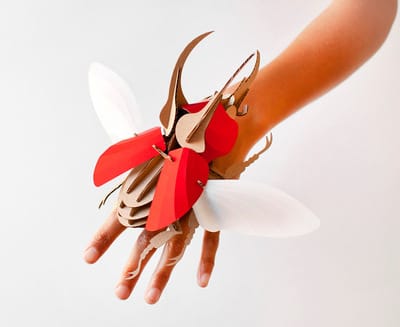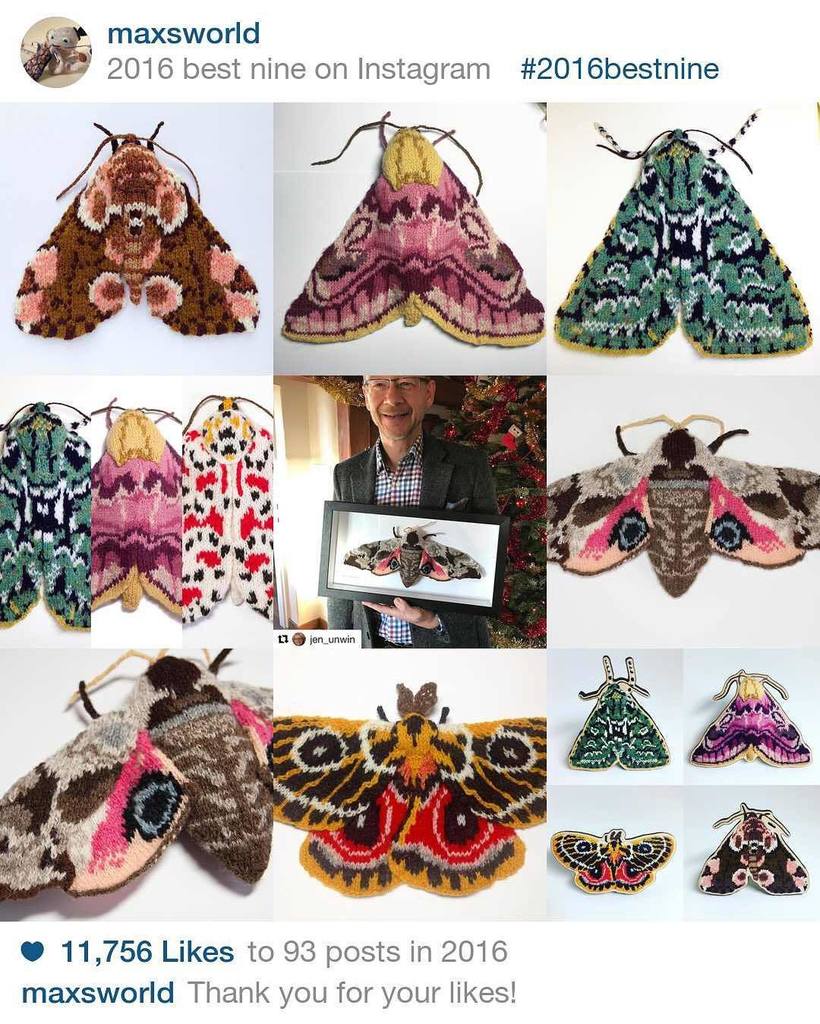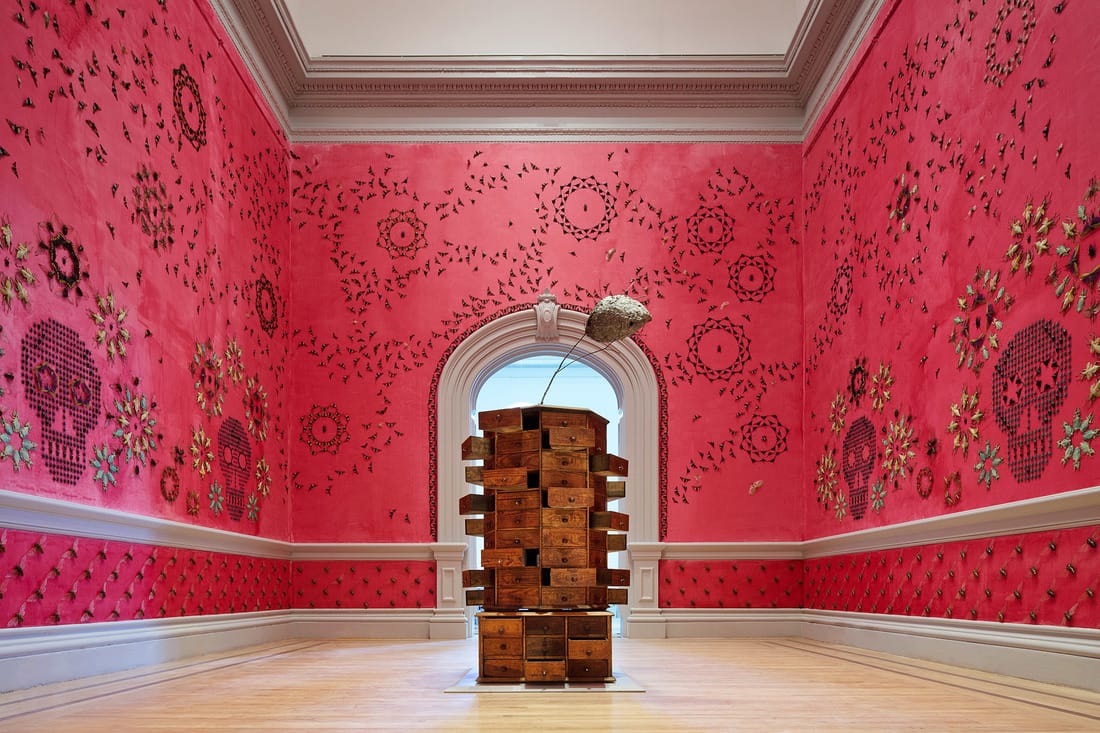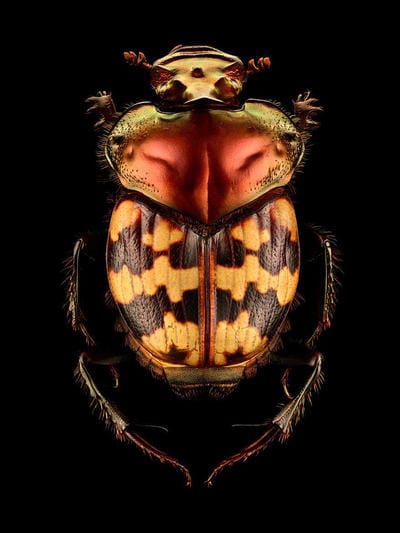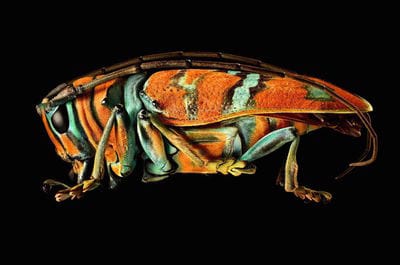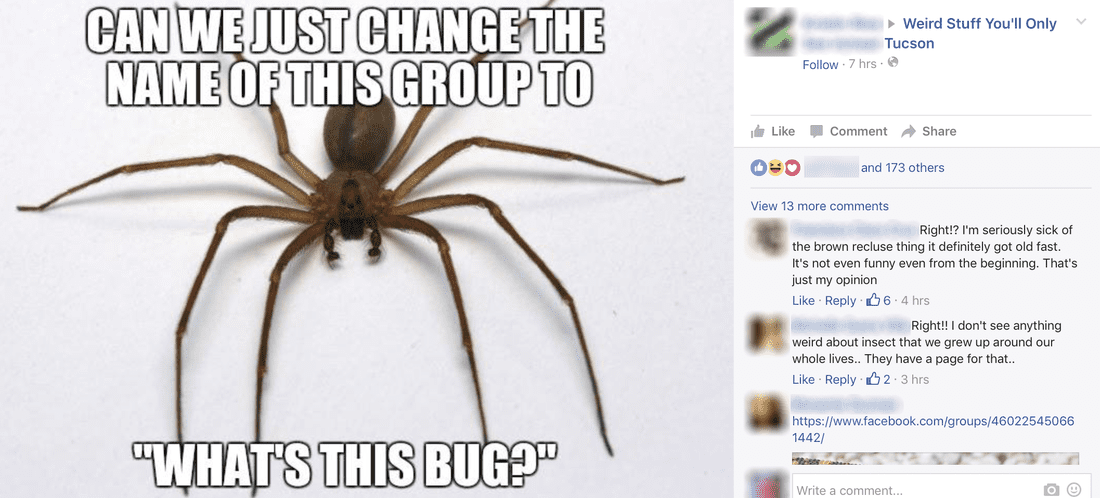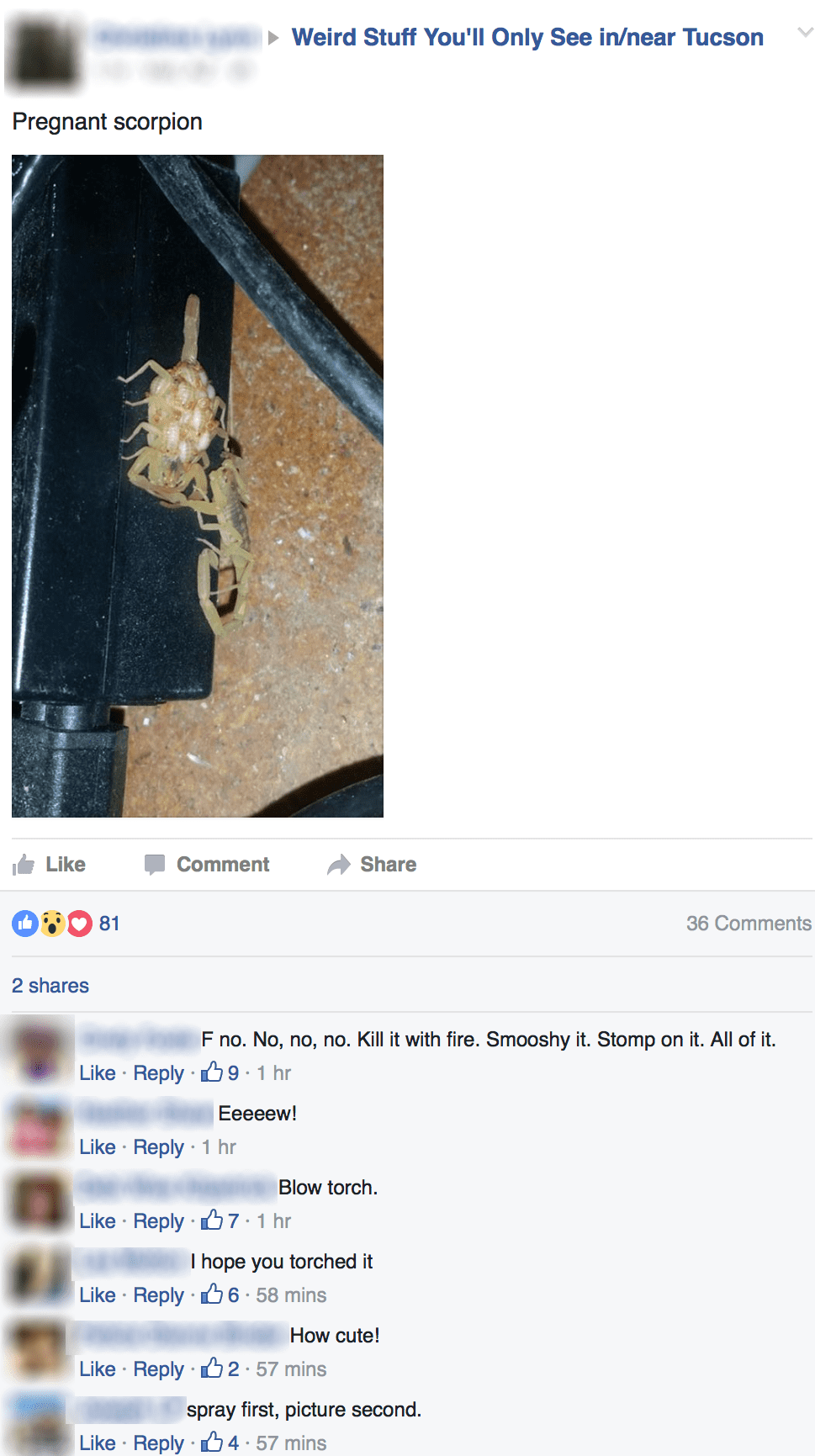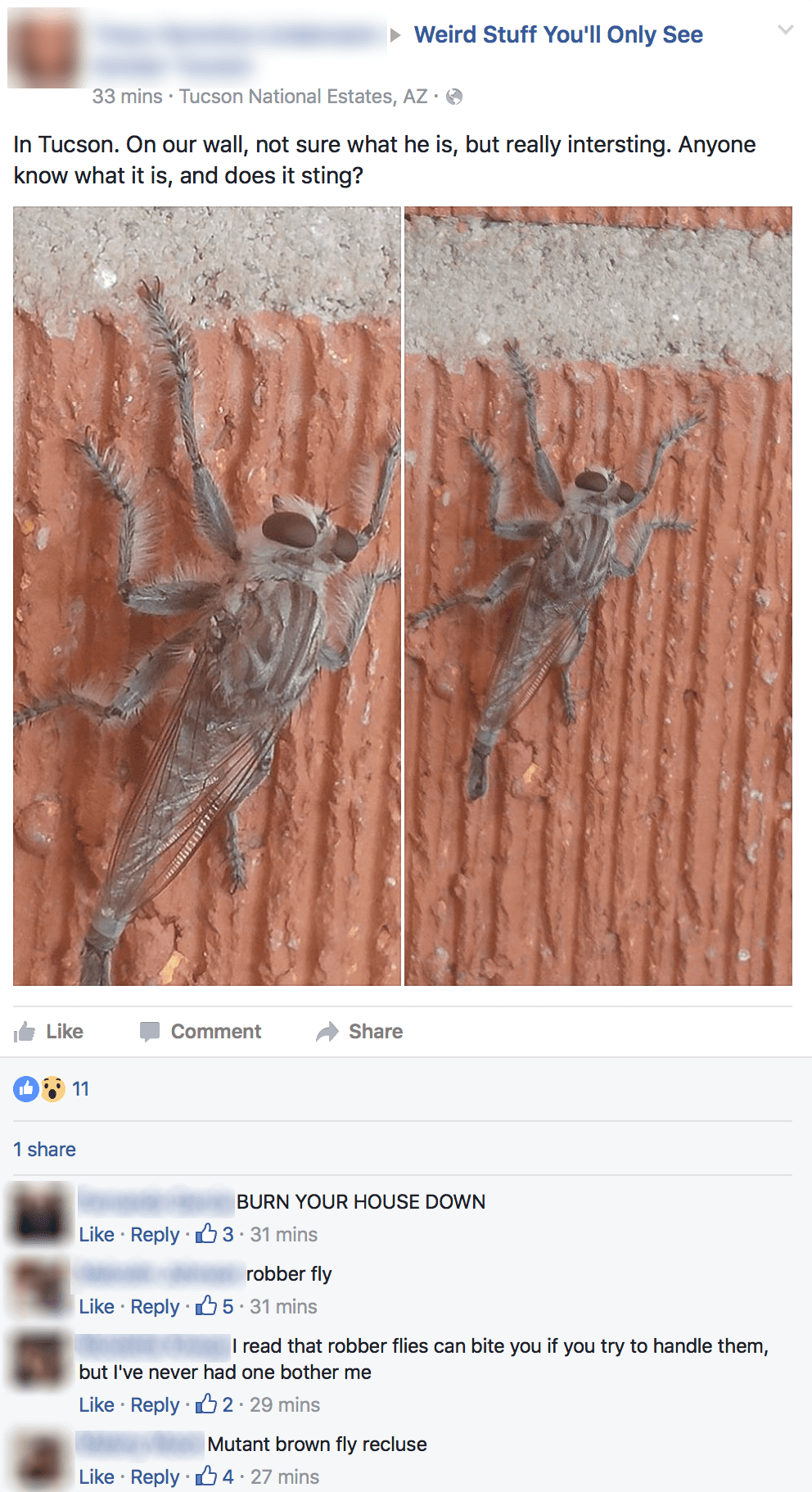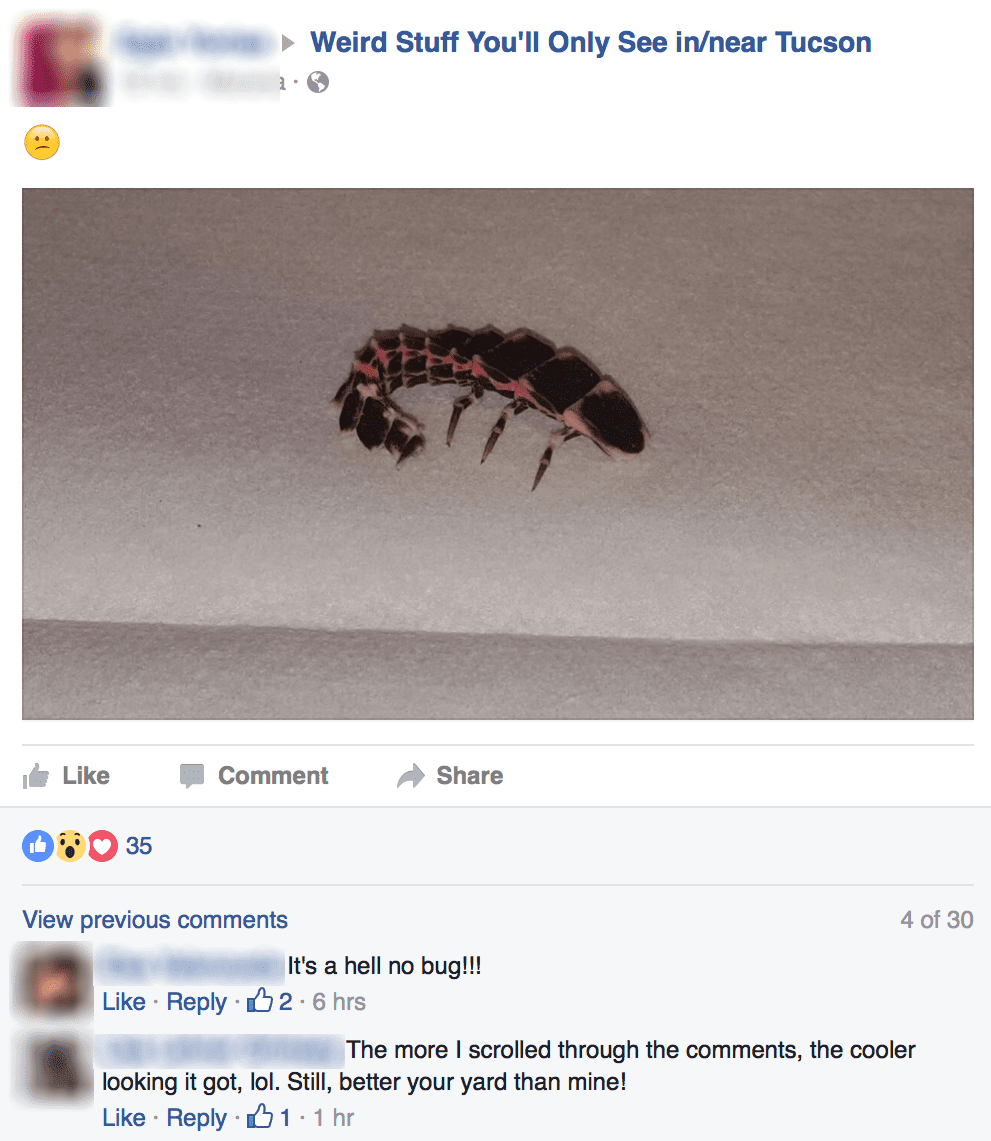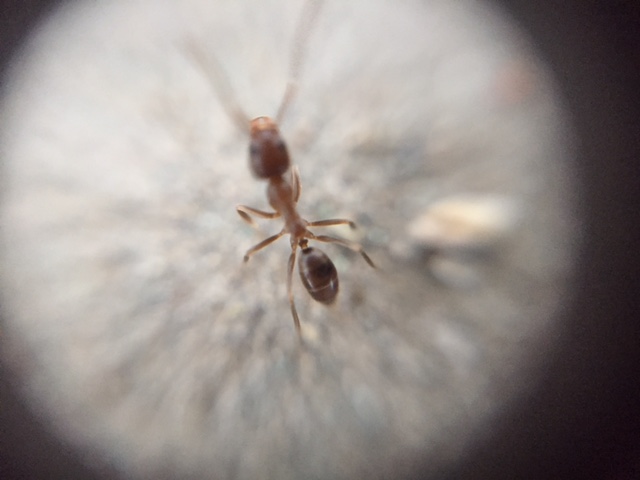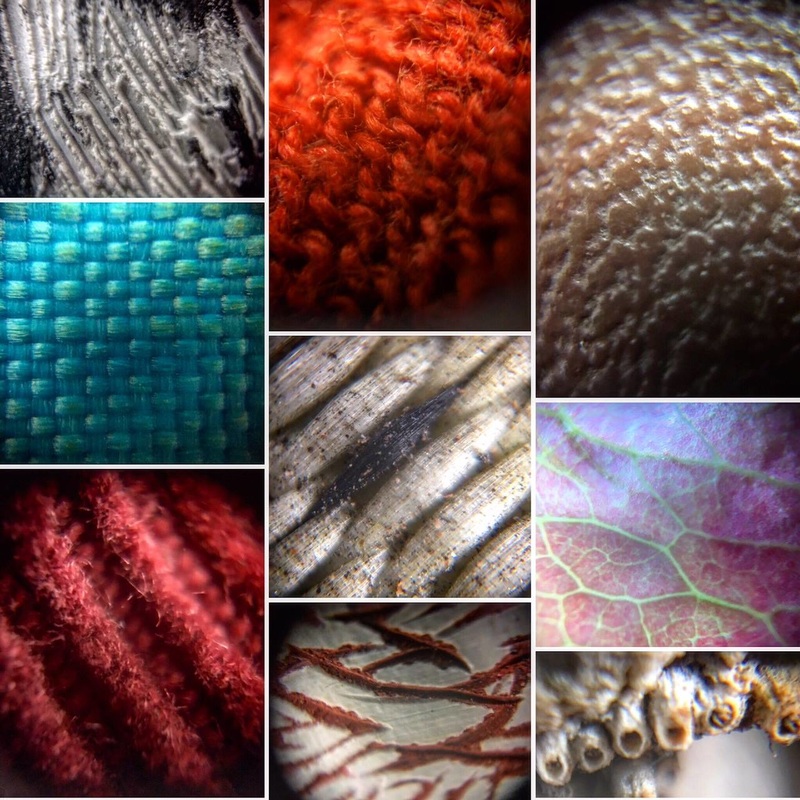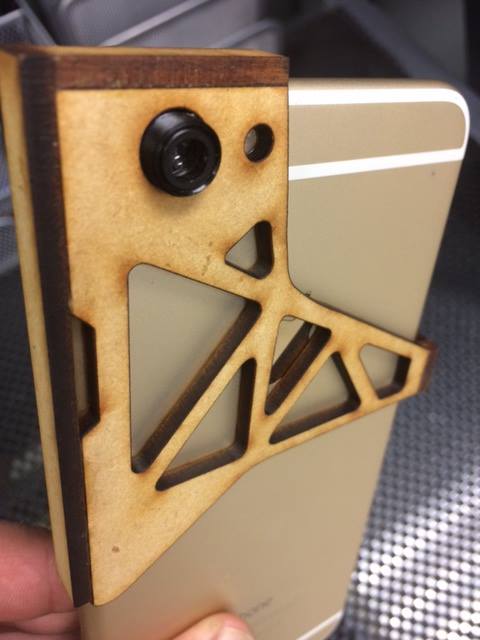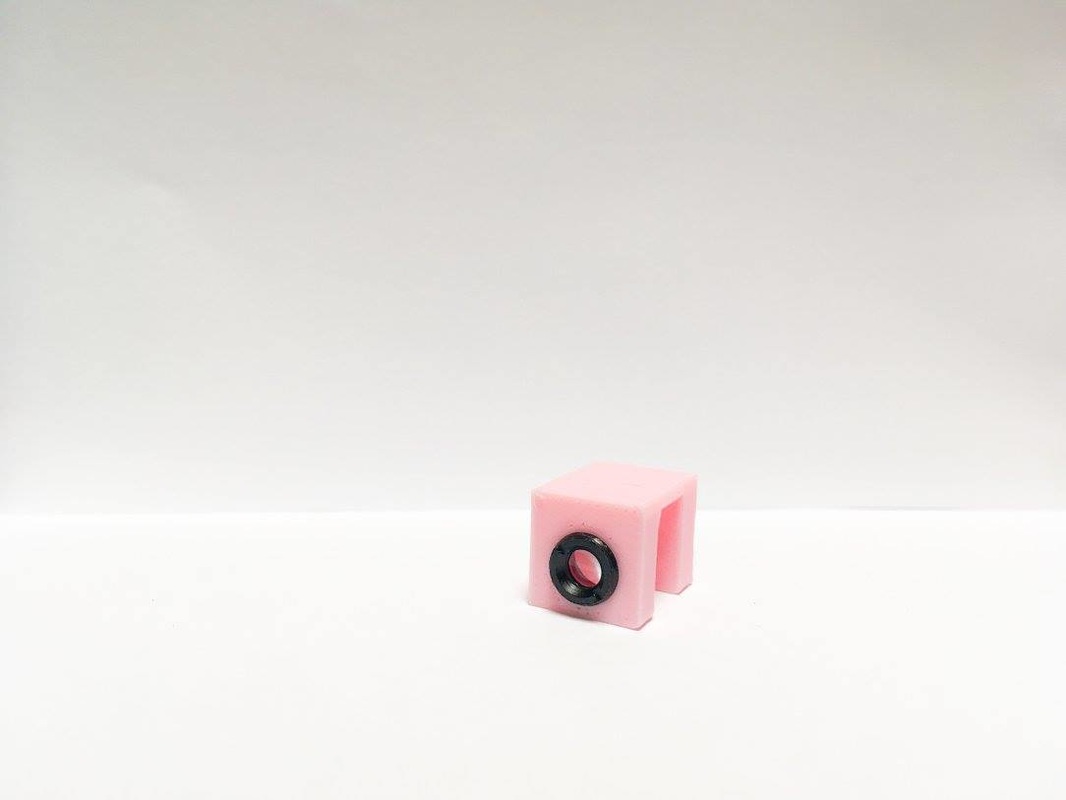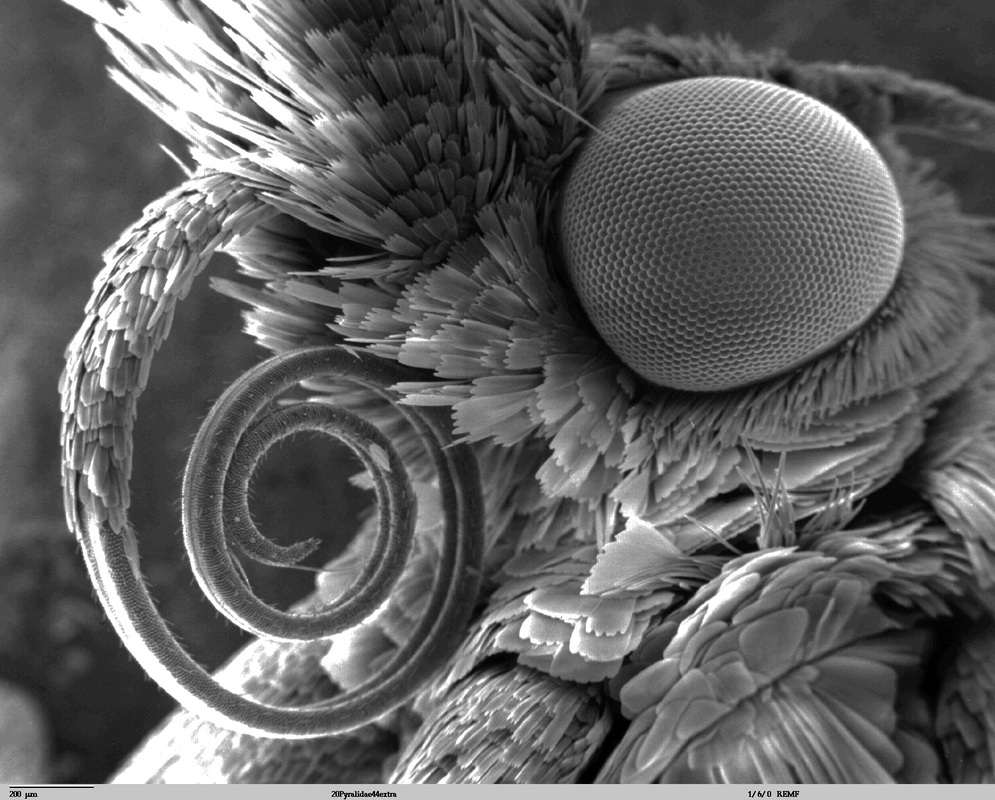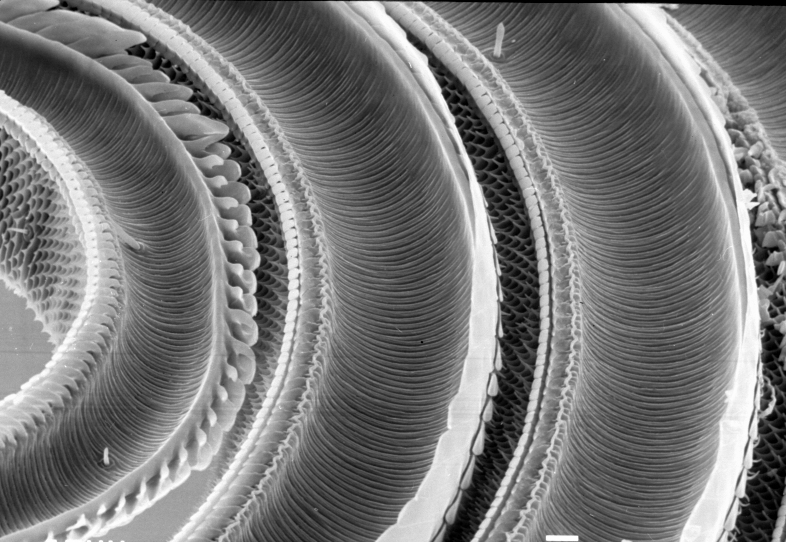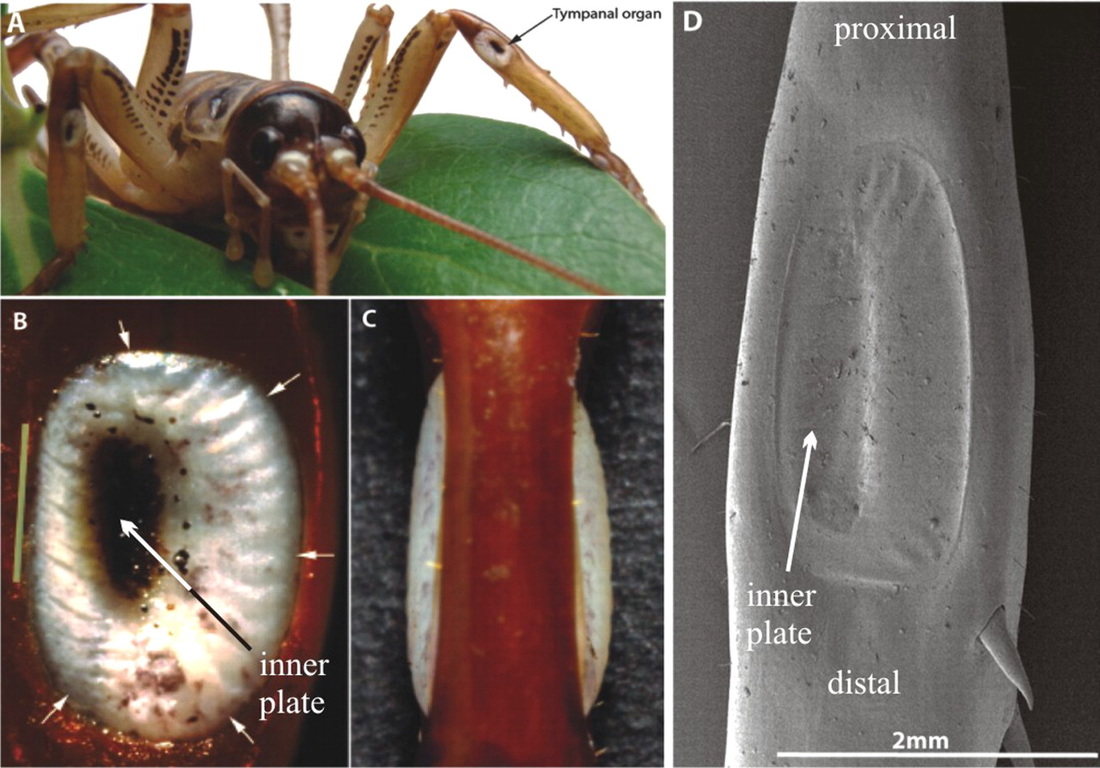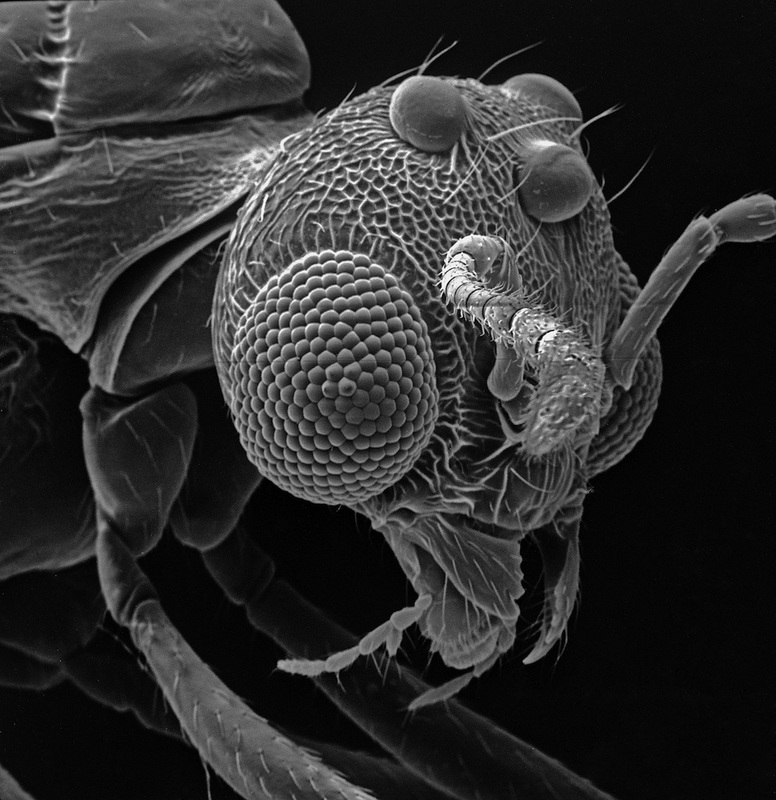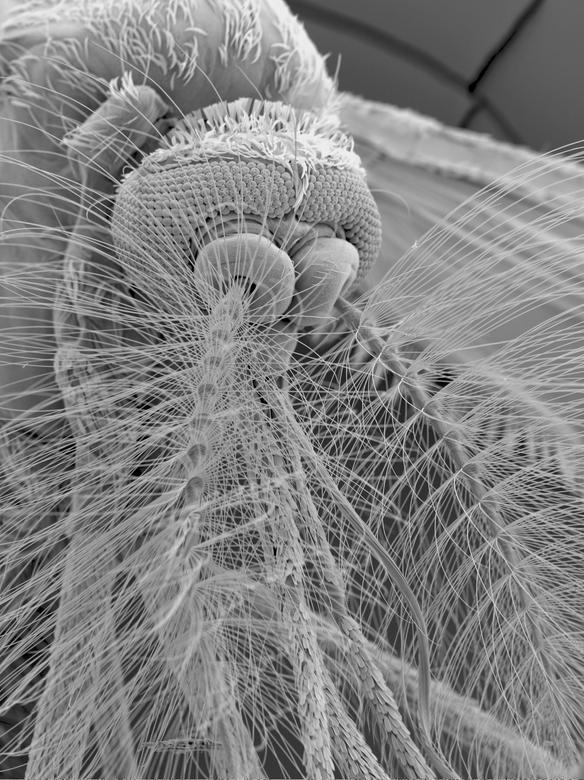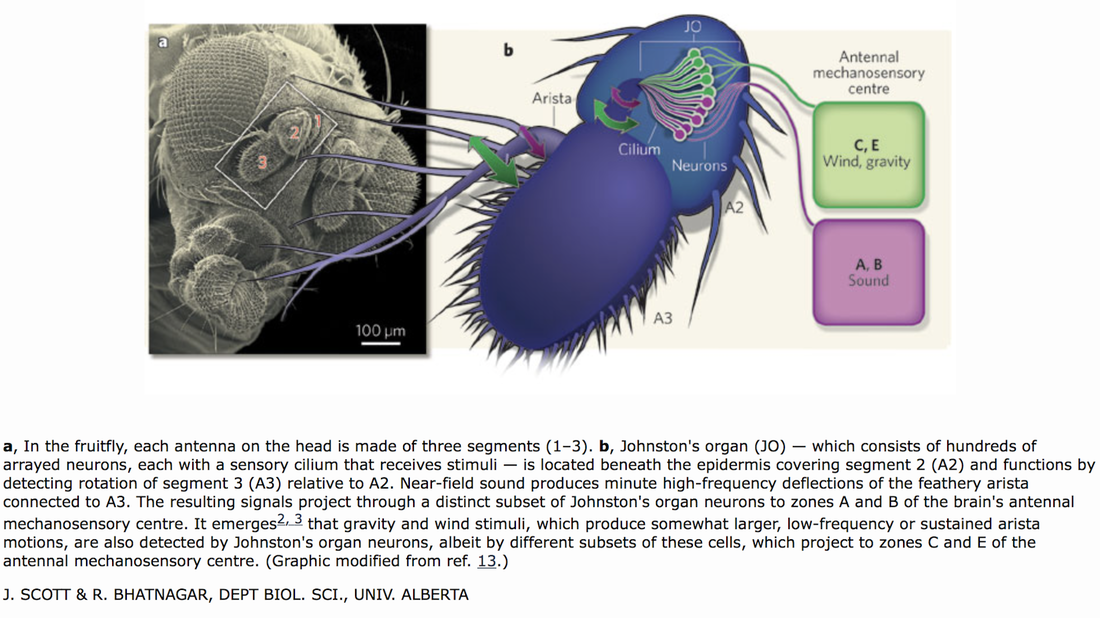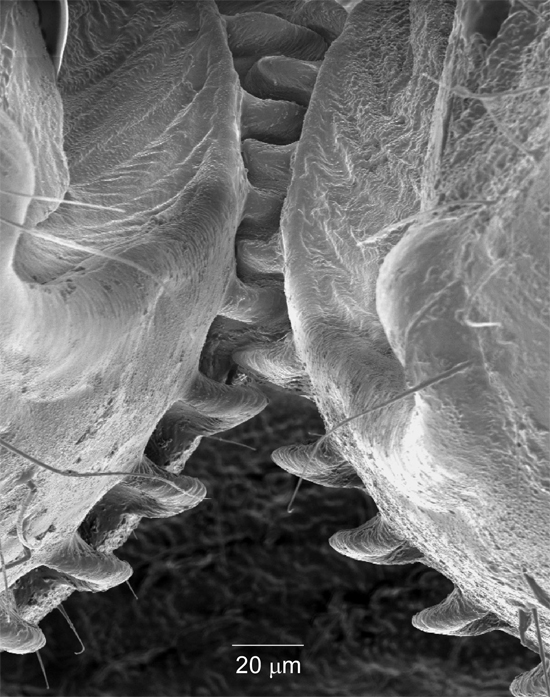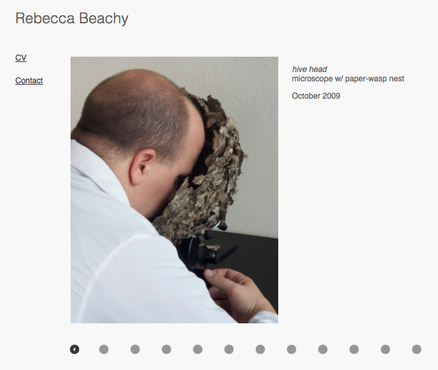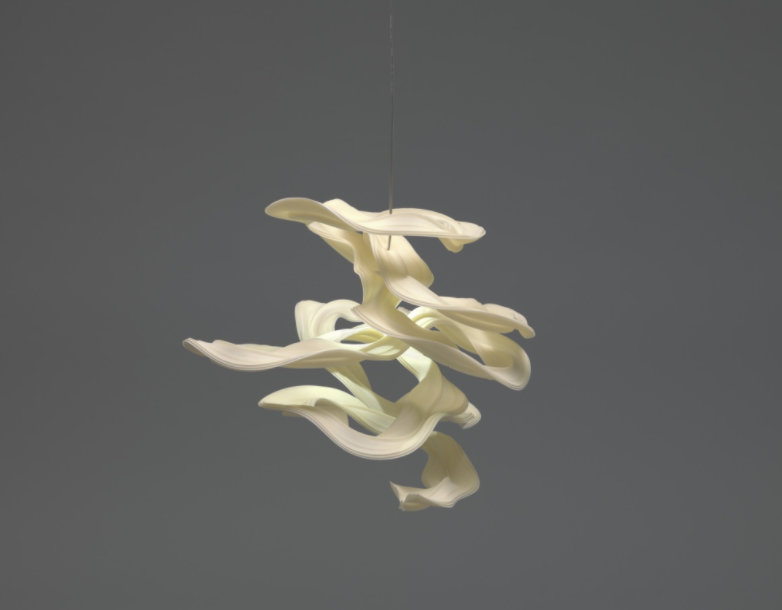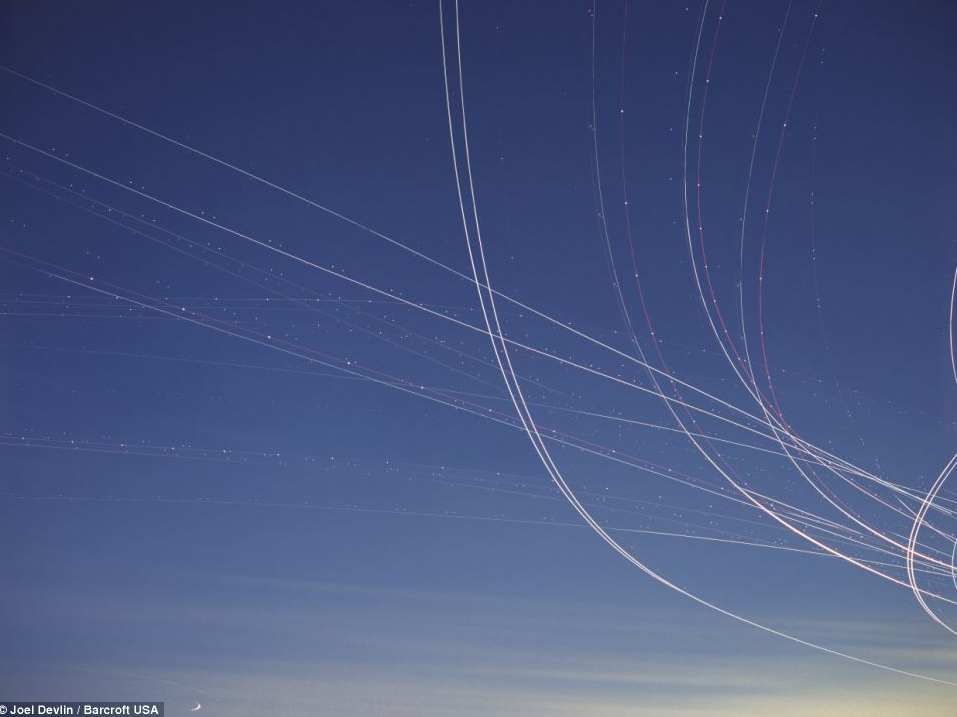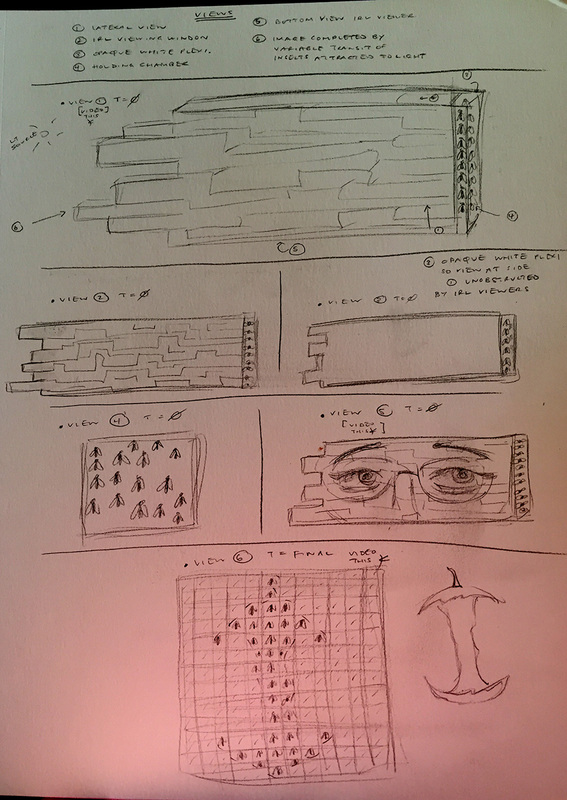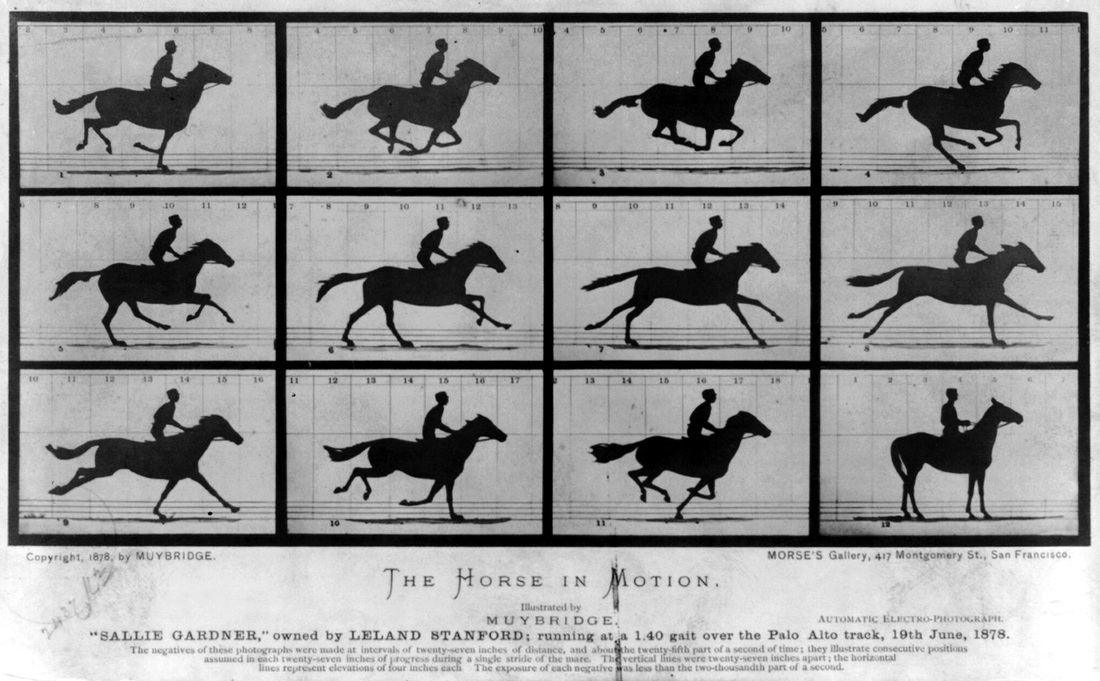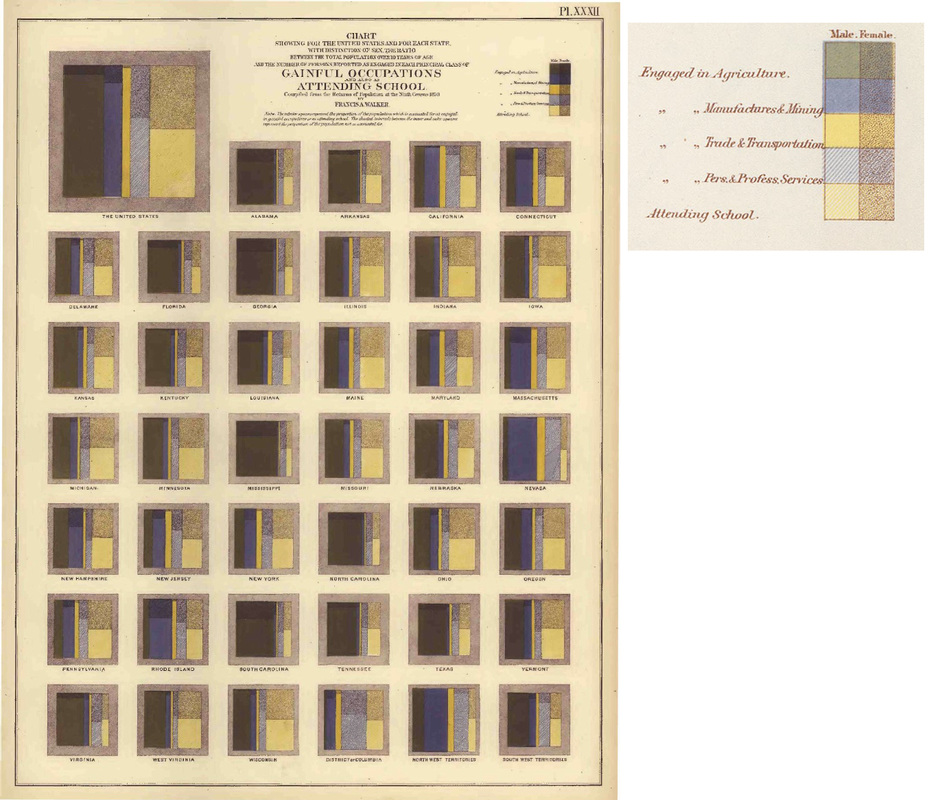|
Cara's update Brittany and I have had an incredible partnership - it's felt easy, dynamic and insightful. So I’d say that’s our primary accomplishment! I’m excited about our project which is fairly well-planned, but with still a few final things to work out. We took a bit of a pause so that Brittany could focus her full attention on her incredible installation at Transmediale. I ordered 100 green banana roaches, so I’m hoping they can play a role in the final piece. I look forward to the final planning and execution of our work. I can’t stop imagining someone in an evening dress leaning into a mask of green roaches. Excited to make it happen! Brittany's update
Cara and I have had a great partnership working together in this residency. Most of all our compatibility has been great in terms of quickly having a lot of things to discuss, incredibly informative, and most of all very fun. I have looked forward to talking with her every week and she has been incredibly generous in helping me with questions outside of our own project as I embarked on something new for my piece at Transmediale. To be honest, in the beginning, I was skeptical of a process that would manifest itself online, especially in regard to making something or coming up with a final project. I have found this process to very useful and the gaps that are created due to lack of face-to-face meetings have spurred some of the more interesting jumping off points for our process and project. I have enjoyed this so much that I am trying to figure out ways that distance collaborations via online could happen again within my own art practice. This has been one of the more fun collaborative processes I have been a part of and it has informed my art practice a great deal and having Cara as a friendly resource has been incredibly helpful. Most importantly Cara has made me feel much more comfortable in asking questions about specific species / sciences / insects that hasn’t made me feel inferior or intimidated as an artist trying to engage with things that are not my expertise. I am incredibly excited to start working towards our physical project. Cara and I are both easily excited by many ideas and all of the complex possibilities that working with insects can provide so it took us some time to land on a final project idea. I believe we finally landed on a piece that we are going to begin collaborating on making together that involves pushing human’s proximity to insects, the era of the selfie / monitoring, and amusement part tactics of commercialization of an experience (like having your picture taken on a roller coaster). We are going to begin working on a vacuum cast plastic face. Once a face has been detected, a light will illuminate, drawing the insects towards someones face while simultaneously activating a camera to take a picture. We have spent some time trying to figure out what kind of insects to use, Cara has some new cockroaches that I am excited to learn more about. Overall, I have been incredibly thankful for this experience, have enjoyed it immensely, and am very excited to finally begin working on our own piece together.
3 Comments
Brittany's update As Cara mentioned I have been moderately away from our blogging to complete a large installation project utilizing ants in a new sculptural project titled Primitive Borders, 2017. I was invited to participate in the 30th year of Transmediale in Berlin. The exhibition I am in is a 5 person show that is part of the 3D Additivist Cookbook. Primitive Borders is a speculative and experimental installation using ant gel originally developed by students to test the effect of zero gravity on ants. In a longer line of artists using ants and ant farms as a metaphorical material, I've been working on a series of projects over the last 7 years that are about the human race being the most expansive pest on the planet. This new work is a smaller prototype that investigates the potential processes of a society adapting to futuristic materials and a forced living structure. The ants exist within 5 structures that are created using primitive forms through digital fabrication techniques. A geometric primitive is a simple form that is a prepackaged building block within 3D modeling software. The ants can freely travel from one primitive cluster to another, crossing borders to possibly create alliances or enemies, with many perishing in the process over time. As I watch them travel from one form to another, some blockaded, abandoning some lands all together, grouping together in new places, sometimes seeking escapes, I can't help but not ascribe it to our current political climate. Here is a link to the description of our show On the Far Side of the Marshlands, which is about borders radical boarders and typographies: http://www.artandeducation.net/announcement/on-the-far-side-of-the-marchlands/ What excites me most about all of this as it has brought so many new ideas to mind and I am excited to finally get to work with Cara on building our project together once I am back and have wrapped up this piece- it has been an interesting learning experience building a system around the architecture of a building. Cara's update Brittany and I have leaned toward decomposers for the insect inhabitants of our final piece. We’ve also talked a lot about audience interaction and perception of the piece. Brittany has been interested in the idea of vacuum-created masks that visitors can put their faces in. With all of these things in mind I created this portrait of myself with some Panchlora nivea (the green banana roach) inhabiting a “mask” against a larger backdrop of the roaches doing their thing. Brave visitors could then take snapshots of themselves like at a theme park ride. I think its fascinating that we have converged on this bright green organically, given this: And finally, to increase popularity for our piece perhaps #SaltBae could sprinkle in the roaches at the opening in New York? ;)
Cara's update Brittany and I have not finalized which insects will inhabit our final piece. We have talked a lot about this, particularly trying to think of how different insects will be perceived by general audiences and what impact that will have. This week for the blog I decided to try to understand how people view insects via tattoo art. What I came up with is a trend that follows my perception of how folks generally perceive insects –distant from us and somewhat fantastical. So it was not surprising to find that, in contrast to the dolphin, cow, giraffe, wolf, bear and lion tattoos I checked out (which generally look like the standard animals they are modeled after), most insect tattoos are rendered with a good bit of artistic license and often transmogrified with gears, crystals, spikes, etc. Apologies in advance for being unable to find attributions for all of the images, but here is a sampling of my insect tattoo journey. I’ll start with the few I found that clearly worked to display insects as they are - a mayfly (wonder if the owner is a fly fisherperson?), a hawk moth, and then – joy to my entomological heart! - some that are actually labeled with both common and Latin names (with just a couple of small spelling errors -- Chrysochroa buqueti and Papilio eurilochus) And the many artistic takes… I have to say that this curly-antennaed cockroach is much cuter than the standard kind – though I would venture to bet that the owner was thinking she was getting a beetle. Panchlora is a genus of tropical/subtropical green roaches that is only found outdoors and so not considered a pest. And finally, I’ll finish with Rick Genest, aka Zombie boy, who is a Canadian man who holds the world record for the most insect tattoos - 176. His aim is a celebration of the decomposition of a human corpse.
There is a cockroah-esque organism on the top of his head and then many arachnids on his torso (which are not decomposers nor technically insects, but I’m sure they are included in the overall count.) Hard to tear your eyes away, no? Cara's update As a science communicator its pretty thrilling to be two titles away from President Barack Obama in Science this week with a piece about the insect festival that I head up. However, it's a little disappointing that this 285 word feature is behind a paywall (and at least a bit ironic, as its in a series titled, ‘Outside the Tower’). Its had me thinking about access to information, and the forums available for us to wrap our minds around the waves of change that science spurs. And, of course, I’ve thought a lot about the credit that scientists and communicators do or do not get for participating in these various arenas and what that means for the possibility of vital discourse. Others have written about these things here and here. All of this has made me appreciate the role and importance of SciArt anew. Its often beautiful, and / or thought provoking, and (relatively) accessible. So if you’re looking around for gifts (Valentine’s Day is around the corner!) why not check out SciArt on Etsy? Follow #sciart on Twitter or Instagram to find artists or works that you love. Or give the gift of a lifetime subscription of SciArt for just $60? A big nod of gratitude to the folks at SciArt Center for all of the bridges that they create!
Brittany and I chatted early last week and she is deep into the final stage of her work for Transmediale in Berlin, Germany. Many of the techniques that she is using for that project will help us with our work for the residency so I’m excited for when she has figured everything out and is ready to share!
Brittany and I talked about a new app called ‘uMake’ for creating 3D sketches. I downloaded it for my new iPad Pro (thanks Santa! AKA airmiles) and it seems great. (I’m hoping Brittany will have a chance to download it before she jumps on her transatlantic flight.) I fired it up, but am still at the stage where its easier for me to draw multiple angles in my sketch book. It looks promising though… 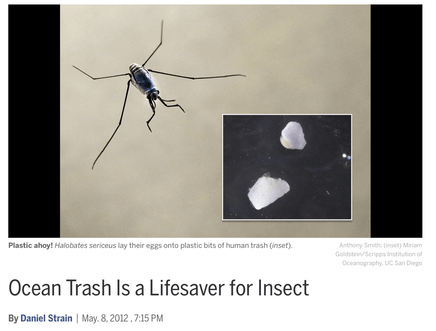
In Week 6 Brittany mentioned research about mealworms that can eat plastic. My latest issue of American Entomologist arrived and May Berenbaum wrote a great article about insect-plastic interactions - ‘Chance the Wrapper.’ In addition to the aforementioned mealworms, she wrote about a few other insects that are using plastic in interesting ways. A pelagic (neither close to bottom nor shore) water strider once with few places to lay eggs (think driftwood bits) is having a veritable field (ocean?) day with all of the plastic now adrift at sea.
“We netted, in one scoop, 833 insects and a single egg mass with an estimated 70,000 eggs on a plastic gallon (3.785-liter) milk jug.” Cheng & Pitman, 2002.
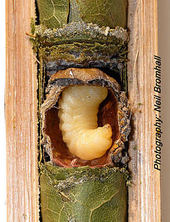
Another interesting case is of two leafcutter bee species that have retooled plastic bag bits to create their nests. Like many bees, leafcutters are solitary (that is, they don’t live in a hive like social honeybees) and make individual brood cells for their offspring usually within an old stem. Leafcutters generally make their brood cells with cut bits of leaf – you may have noticed half moon-shapes missing from your landscape plants in the spring/summer. Here is a cross-section of an au naturel leafcutter bee nest complete with larval bee (head at bottom right).
The bees in the study simply incorporated tiny bits of plastic. Alas! Not actually mini-shopping bags, but the images in the study weren’t as much fun to look at as this one ;)
“It is interesting to note that in both bee species [studied], the type of plastic used structurally reflects the native nesting material, suggesting that nesting material structure is more important than chemical or other innate traits of the material.
Our understanding of how plastics spontaneous integrate into natural ecological processes will increase as more human-made material and products build up in both urban and non-urban landscapes. Even more so, as ecologists, naturalists, and all hobbyists having access to a camera and Internet can quickly disseminate unique observations, which can be used to both engage the public, and contribute to empirical research (Silvertown 2009). The extent to which human-made products such as plastic become a fixed part of the landscape might act as a novel selective pressure further delineating urban-adaptive and urban-avoiding species and subpopulations.” [MacIvor & Moore 2013.] Brittany's update Cara and I are planning on talking later on mid week. It seems like we have both had busy holiday week(s). Its interesting that Cara posted an image of Jennifer Angus as she has been an artist that I have followed for a long time. Admittedly I have been feverishly working on a separate project that involves harvester ants that will ship to Transmediale in Berlin, Germany in 7 days. Cara has been great in answering some basic questions that I have had for the research for this. I have been developing digital 3D Forms to be CNC milled that I have been using as positives for vacuum forming to assemble custom Ant Farms. Each of the farms have a different shape (a primitive, a common set of basic shapes found in 3D modeling software platforms). Each primitive represents a continent and the ants will be able to travel from one farm (continent) to another through a system of tubes. The CNC forms are then vacuum cast / formed (a process I have been teaching myself this week) using plastic and will be joined together using a laser cut center (video of vacuum forming slowed down below).Its a highly experimental piece that takes some inspiration from the artist Yukinori Yanagi who I had posted about in a previous blog. It is interesting to me that Cara discussed the cardboard beetles as I am working on different digital fabrication techniques. I am interested in their laser cut forms and the simple materials that they are made of to represent a complex animal. More soon after we talk this week, but here are some process images of the other project that I am working on Test Ant Farm with ants in “ant gel” // a commercial product you can buy at most big box stores Conceptualization drawings (I am not a great illustrator) Video of Vacuum Forming Cara's update Happy New Year Everyone! In contrast to last week’s post, I wanted to celebrate some explorations into insects’ wondrous beauty. A breath of fresh air for 2017. Cardboard beetle creations from artist Joop Bource of Assembli: {These are available on Etsy - I just bought THREE! *.*} Max Alexander handknits these moths and give them the snuggly look that I often think of when looking at a fluffy specimen. Its on my lifelist to visit one of these incredible rooms/worlds that Jennifer Angus creates. 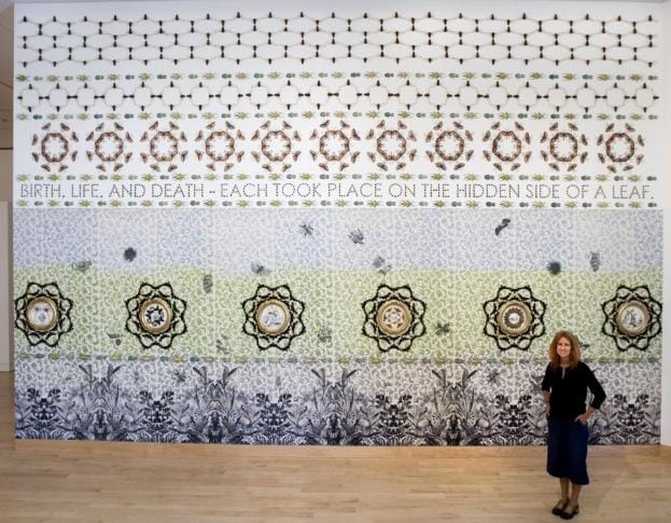 And finally, large format prints with breath-taking details by photographer Levon Biss: Feel free to type in to us with your favourite insect #sciart below!
Cara’s update #TheStruggleIsReal This week I thought I’d highlight how people generally think of arthropods / insects. Side note: Arthropods is the larger container “group” (a phylum in the Linnaean system) and includes animals with jointed appendages, segmented bodies and an exoskeleton. Insects (a class in the Linnaean system) is a narrower group that includes animals with an exoskeleton, three part bodies and six jointed legs. I’m presenting here a selection of posts taken from a Facebook group where people share odd things they’ve seen in or around Tucson. This past summer there were A LOT of “bug” posts - so many that someone finally posted this: The posts I wanted to share are about a mother scorpion (they brood their young on their backs! Cool, eh?), a robber fly (excellent garden predators) and a firefly larva (a baby beetle that when it ecloses as an adult everyone is ready to love ‘em! Though I admit as a juveniles they are reminiscent of that guy from Star Trek, Khan’s brain-eating worms -- Reading through the threads you get a sense that most folks are rather intolerant of these forms of life.
Brittany's update This week I have been thinking through some of the same processes that Cara and I have talked about in terms of the reliability of insects to humans and ways that we might break barriers or at least promote a way that humans might interact with insects that lends to an understanding rather than repulsion. I have spent much of my art practice thinking through these approaches, about how to step outside of a viewing scenario that puts an animal on one side of the glass and the human face on the other. As an artist I feel that it is my job to create mediated experiences or objects that lead to the allowance to approach/obtain information (or formulate a concept or opinion) in a new way. Cara and I have talked a lot about spaces that create an experience- she points in her post to how easy it is for humans to acclimate, accepted, glamorize, and even embody superheroes whose abilities are animal(insect) based- Spiderman, antman, wasp woman etc. The issues of branding etc. I recently went on a trip to Universal Studios in Los Angeles where I went on the transformers ride. They had an actor come out in an elaborate bumblebee costume and enact the characters mannerisms with its half car bee-inspired body and I couldn't help but watch as the crowed cheered on its human bee-inspired-shape-shifting-car-hero. If it were a giant anatomical bumblebee suited person performing this would not have been the case (maybe if it had googley eyes and an overly enhanced cartoonish smile…..something off of the front of an Eric Carle book. We will talk more this week about beginning to formalize some of our ideas into a firm concept, material set, and hopefully begin some more resolved sketches with all of the aforementioned in mind. This semester I gave my digital fabrication students (a class where students learn 3D printing, laser cutting, laser scanning, and cnc mill etc.) the task of designing a microscopic attachment for their phone. I gave them a 10 cent laser pointer lens and the rest was up to them. The designs spanned across being simple adornments to purely functional. The goal was to get them to expand their ways of visual observation by having to look at things both up close (microscope) and far away (telescope) and make a piece that examined textures and patterns in both places. Looking at Cara’s SEMs I cant help but think of some similarities- (though my student’s images are definitely not scientific grade quality) all of us trying to glean a bit of insight into information that seems to foreign to our own sensibilities. I also cant stop thinking still of the piece of glass in a microscope separating the eye from the surface, the piece of glass separating me from my ant farm in my office and how all of these mediated surfaces shift our modes of observation, tangibility, and ultimately our feelings of connectedness. 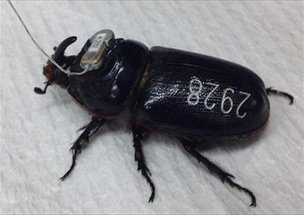 (Photo credit: Matthew Siderhurst) (Photo credit: Matthew Siderhurst) Cara's update I learned of another example of insects loaded with technology that I thought Brittany might dig. They called them ‘Judas beetles’ after a technique used in livestock where a goat leads other animals to their slaughterers. The beetles are fitted with radio transmitters and laser-engraved identification numbers and then lead researchers to their hard-to-find breeding spots so that these destroyers of coconut can be managed. A dream of mine is to somehow elevate the status of insects, for their beauty and their critical roles on the planet. I’ve always wondered why kids (and well, everyone) seem so keen to love Spider-Man or Ant-Man or Wasp Woman, but less apt to take a shine to the real thing. A branding problem? Brittany and I talked last week about making some 3D printed insect panels and I thought about creating hero costumes from the panels. To start this conversation, I found a selection of Scanning Electron Microscope (SEM) images to try to bridge the gap and to highlight how jawdroppingly beautiful things not of our scale often are. Note, the SEM process is also quite striking – for typical insect samples the specimens are dried, sputter-coated with gold and then exposed to an electron beam inside of a vacuum-sealed container. The electrons interact with the surface of the sample and this produces images with resolutions better than 1 nm. (For reference one of the hairs on your head is 75,000nm in diameter. Here is a neat interactive animation that allows you to warp-wrap [!] your mind around tiny things better. GUSTATORY / TASTE Although moth mouthparts look like a party horn, they are actually a canal through which liquids are consumed. TACTILE / TOUCH Insects often use their antennae to discern features of surfaces. Shown at left are three “flagellomeres" - segments of an insect’s antenna covered with sensory hairs. At right, the serrated surface of a parasitic wasp’s egg-laying anatomy - her ovipositor. AUDITORY / HEARING Not many insects can actually hear – moths use sound to avoid predators, some parasitic insects use it to seek out hosts, and crickets, and locusts to detect the sound of mates. It is not entirely clear to researchers why the weta have tympanal organs on their legs. VISUAL / SIGHT Most adult insects and many juvenile insects have compound eyes that are composed of smaller units. Pictured here is the face of a parasitic wasp where one eye with these individual units are discernible. On top of the head are the three “ocelli” or simple eyes that quickly respond to light and dark. Photo credit: David M Phillips:http://www.slate.com/blogs/behold/2014/08/07/david_m_phillips_ photographs_ insects_with_an_electron_microscope_in_his.html OLFACTORY / SMELL Male mosquitoes have fluffy (plumose) antennae to detect female mosquito pheromones. Males don’t bite, so if you see a fluffy-antennaed mosquito no need to fret he’s just looking for a mate or some flower nectar. VESTIBULAR / BALANCE Johnston’s Organ in the fruit fly Drosophila melanogaster is responsible for distinguishing between gravitational, mechanical, and acoustic stimuli. PROPRIOCEPTION / RELATIVE POSITIONS OF BODY PARTS Insects have hairs or other projections that allow them to know where parts of their body are relative to one another. This is a close-up of the underside of a planthopper’s legs that include gears that orchestrate their quick jumps. I liked the quote from the scientist that first discovered them:
“We didn’t have to go to some obscure monastery in Outer Slaubvinia to find these things,” [Gregory Sutton from the University of Cambridge] says. “We had to go to a place called The Garden, in The Backyard. Either the most complicated gearing in nature happens to be in our backyard, or there is stuff that’s vastly more intricate and complicated that hasn’t been found yet.” Brittany's update After enjoying the holidays and working through the busiest time of the Semester, Cara and I had a chance to catch up this week to talk insects, installations, inclusion v. dissonance. Cara and I traded off blog writing responsibilities for two weeks rather than writing individual texts. We have been discussing what our final piece should look like, do, and ultimately how we will attempt to create something that has a broad enough signal / message for as many people as possible to understand. We spoke a lot about dissonance v. inclusion in relationship to how humans react to insects in various forms. Cara said something interesting to me that really resonated (hopefully I have this written down correctly)- “Insects are the last animal that we interact with on an involuntary basis”..I would further say that we also most frequently interact with insects on an involuntary basis. This is not the same as spending time with your domesticated dog or cat, but rather we do not typically plan our interactions with insects. These instances come when we step on them with our shoes, swat them from our faces or food, when we exterminate them from the perimeters of our homes, when a spider crawls into the corner of a room and makes a web or a flying insect comes crashing into your windshield as you zoom down the highway. Our interactions with insects are generally unwanted, unexpected, and sharing spaces with them is typically uninvited. 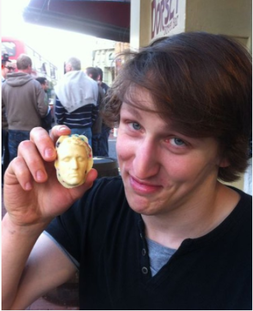 From: http://www.instructables.com/id/Realistic-Chocolate-Heads-from-3D-Prints/ From: http://www.instructables.com/id/Realistic-Chocolate-Heads-from-3D-Prints/ Cara and I talked about ways to push the boundaries of comfort and how to have a human beings interact with insects in a way that is not necessarily comfortable- to re-orient the way that one might interact with an insect, in a way that brings the two together in a way outside of the stepping and swatting. As I was thinking of ways that we might design something, I was telling Cara about ways that we could use vacuum formed plastic to create a place where someone would stick their face into as insects move around or towards it somehow (we have yet to determine the type of insects we will work with for our piece). Here is an example of vacuum formed plastic made from a 3D Scan, print, and ultimately vacuum formed piece of plastic (top left). I began thinking about a good friend Rebecca Beachy’s piece that was made in 2009 titled Hive Head that uses a vacated wasp nest and a microscope where viewers are forced to put their face in this space to access the information on the other side of the microscope lens (below). We have talked a lot about a one time occurrence in a piece, that insects would migrate from one area to another based on something sensorial like reaction to light etc. Where our conversation began to get very interested for me was when we discussed how to document and capture the experience of these two animals (human and insect) having this encounter and marketing it in an almost universal studio’s type way. I imagined someone sticking their face in some sort of environment where insects become (uncomfortably) close and a photograph / selfie being taken in the same way that rollercoasters snap a picture of you on the ride when you least expect it.
Brittany and Cara’s Update Brittany is busy with a show in San Francisco. I’m hoping she will have some photos of it for us next week. First off - acknowledgement of the elephant on the Internet. Many rifts in the U.S. have been laid bare with great certainty this week. It has been a challenge to push this aside long enough to create anything new. Please be safe yourself, and with others. Brittany and I agreed that I should try to render some concept sketches of each different angle for what we’re thinking about making. I’ve included the time stamp for each of the views as we imagine this piece will appear quite differently over the hour (?) that it takes the insects to make their way toward the light source at the end (View 6). From view 6 the insects will draw out for their function; decomposition in this case depicted by a friendly apple core, final actual function TBD. Some channels will be blocked entirely and others will be blocked at various points along their length allowing for some nice tonal variation (possibly) in the final view. Cameras will record the views from sides 1, 5, and 6. We talked about mementos from the recordings of the live piece. Small multiples seem appealing and I found these historical examples to share. That same yellow keeps coming up for me, but I also love the aging ivory here, how your eye is halted by the grey momentarily, and then drawn to the black.
‘Accessible,’ ‘sparing,’ and ‘calculated’ all come to mind. I’m not sure our piece as outlined really conveys the critical importance of insects as decomposers at a gut level. Although, I also suspect that if it did, it might not be particularly welcome. What is required for us to not take silence for granted? Summer Haiku for Frank and Marian Scott By Leonard Cohen Silence and a deeper silence when the crickets hesitate |
Visit our other residency group's blogs HERE
Brittany Ransom is an award-winning artist, technologist, and assistant professor of Sculpture and New Genres at California State University, Long Beach.
Cara Gibson is a graphic designer, director of Science Communications, and Assistant Professor at the University of Arizona in Tucson.
|

